a composer’s diary
[selfethnographic]
by Pia Palme, from May 2019 to May 2022
25/05/2022
The Anthology is published!
The book is here! I can weigh it my hand, thinking of all the work behind it, with appreciation and gratitude. It looks beautiful, the typesetting and layout is fine. With this publicaiton, the project has come to its end. Time to celebrate together, and to be very, very grateful.


Lockdown restrictions are being withdrawn, public life begins to re-grow and live performances are once again possible. The city is coming back to life, and universities open up fully. What a relief! I can return to Graz to empty out my office at the institute. I have not been able to use the office space as much as was planned; for almost two years, access was restricted. Nevertheless, it was a good place to work!
26 February to 6 May 2022
Saari Residence, Finland
I travel to Finland for the Saari Residence, to work at Saari, near Turku for two months. During that time, I blog under https://piapalme.at/blog-with-saari/

17/02/2022
Working in lockdown
I begin to prepare for the residency in Finland. Making lists of what to take, how to travel.
Still – or rather: again – Vienna is under lockdown, and again performances are cancelled or postponed. I continue to work on the book publication, proof reading, communicating with the authors about their final versions. Irene and I work separately, steadily. Slowed down at times because of illness. Is it Corona, or a ‘normal’ flu? Always, the question remains, in spite of testing. The permanent distancing situation is not good for me, In general, I feel tired of the situation. I empty my office at the Kunstuniversität; I will work from my home, until the book is fully published.
06/11/2021
ZELLWÄRTS
Via train, I travel to Berlin to attend rehearsals and the first performance of ZELLWÄRTS, a piece commissioned by the KNM Ensemble Berlin. Coming from Vienna in lockdown, this feels amazing: a real concert is happening! It feels good to travel, a bit of a ‘normal life’ experience. Working with KNM is delightful, I also like their venue Fahrbereitschaft, in the outer districts of the formerly East. They perform along a precise scenography and direction, developed by Thomas Bruns. The piece is about decomposition – this topic will be in my focus over the next months. It is a text piece, because that is what the commission was about. I wrote a poem to be used for sonification, with brief instruction on how to proceed. I very much appreciate KNM’s performance.


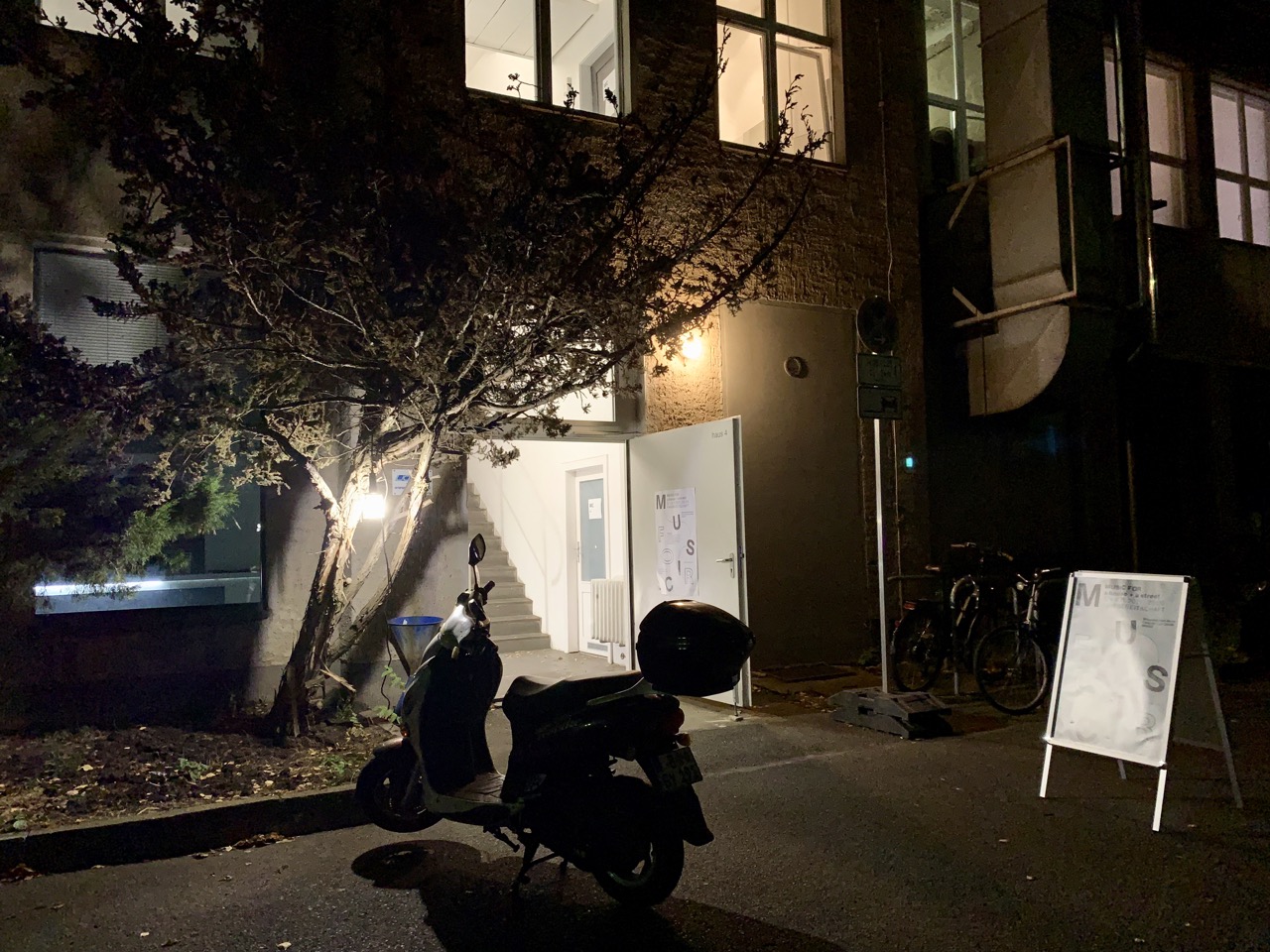




I also meet Irene, she takes me on a nice walk along the Spree. Everything feels friendly again – could it be that with all the distancing, misunderstandings grow like weeds, and suffocate friendship? We have coffee at the beach, and visit the enormous Russian war memorial erected after WWII. It starts to rain. It feels like a holiday to me: open cafes and restaurants! It is overwhelming to be together with so many people again.



17/08/2021
Garden delights and writing blockages
The question baffles me: why is it currently so demanding for me to write for this blog? I observe a certain ongoing blockage since spring, since the last lockdown. Formerly, I enjoyed writing or posting photos and statements. Now, I just don’t feel like doing that. Although I do attend live events again, my outgoing thinking activity seems to be withdrawn from the surface. My cultural thinking process has slowed down, has sunk to the bottom of my inner lake. Like fish in winter, my communicating capacities linger on the bottom of the lake, waiting for better weather, sunshine and warmer water – I should say: the weather is wonderful right now, we enjoy a marvellous late summer. What I observe is about inner weather, about cultural weather. I’m not as lightheaded and outgoing as before, I notice.


Recently I participated in a series of private festivities with friends – these were delightful, warming experiences. Barbara Klein, the former director of the Kosmos Theater Vienna and a longtime feminist activist, invited to a banquet in her garden in the country. The dancer Paola Bianchi was there, visiting from Italy, with her partner, the writer and food artist Ivan Fantini. Ivan is a fantastic cook, for some time during his life he had worked professionally as a chef. Other guests were invited, whom I met for the first time on this occasion. The company and conversation were warm and friendly, although we had not met before and came from different backgrounds, even speaking different languages. I noticed the same kind of atmosphere during similar gatherings in summer, and my impression is that this is connected with the pandemic. People seem to have changed – I have. I appreciate real meetings, I am currently more open and friendly when I talk to people ‘in real life’.
16/07/2021
Musik mit Natur
Diesen Text formulierte ich auf die Bitte hin, etwas zum Thema ‘Musik und Natur‘ zu schreiben.
Unbedingt Musik mit Natur. Das Wort mit ist wichtig; ich mache nie Musik über, in, durch, oder von Natur inspiriert. Als Mensch bin ich Teil der Natur, also auch als Komponistin, und das spielt bei allen meinen Stücken mit. Es gibt keine Wahl. Ich verstehe meine Arbeiten als Ökosysteme, denn zur Musik gehört das gesamte Umfeld dazu: Mitwirkende, Instrumente, elektronische oder sonstige Technik, Orte und Häuser, lebende und nicht lebende Dinge. Besonders im Bereich Musiktheater und elektronische Musik hilft mir die ökologische Sichtweise, den Arbeitsprozess besser zu verstehen, zu planen und gelassener mit Interaktionen und Interferenzen umzugehen. Vom Feminismus über die Diversität ist es zur Ökologie als grundsätzliche Haltung in einer globalen Umgebung, im Anthropozän, ja nicht weit. Manche meiner Stücke sind tatsächlich an einem konkreten Ort verankert, da kann dann ein Baum oder ein Landstrich in den Vordergrund treten, sowohl kompositorisch wie als Visual – wie zum Beispiel beim Streichquartett KREISUNG mit Video und Elektronik, oder bei MORE RADICALLY mit der Sängerin Rosie Middleton. Beim neuen Stück WEITERUNG, das eben mit dem Ensemble Schallfeld, mit Séverine Ballon und mir in Graz uraufgeführt wurde, zeichne ich ‘organische’ Entwicklungen in der Komposition nach, und der Text erwähnt unter anderem meine Faszination mit dem gerade neu entstehenden Vulkan in Island nahe Reykjavik, dessen jugendliches Wachstum ich mir grad supergern via Livestream anschaue … es geht immer mit um den größerer Zusammenhang, darüber, was das mit den Menschen und mit meiner Musik macht, als Teil eines komplexeren Geflechts.
02/07/202
Silences
Still, I feel not like writing as much as before; I notice that this blog is currently thinning out. Thoughts conglomerate in my mind, dancing around like clouds, densifying, dispersing, changing. A state of mind that reminds me of dreaming. Sometimes trains of ideas form that could be interesting and that lead to new terrains – yet, I cannot find words for what I perceive. Real life concerts begin to happen again. So, do we all go back to normal again, without looking back? Performing feels so good again. At the same time, I ask myself: what has happened during the last one-and-a-half years? It is difficult to locate all the memories that I have from this time. What happened, where and when? Is there a gap in my life? It would be too long a gap, I don’t want to lose these precious months.
The performance at Schaumbad Atelierhaus Graz was perfect. With Séverine Ballon and ensemble Schaumbad, new pieces were premiered. Everybody played with intensity and warmth, we collaborated smoothly, and the concert was well received by the small audience that was allowed.
I took this foto of Séverine Ballon from the upper floor; in the rooms, you see artworks by Irena Eden & Stijn Lernout „o-T (300.200.20), 2020“ and Karin Maria Pfeifer „ _blueprint, 2021“ of the exhibition Numbered, Weighed, Divided curated by flat1.
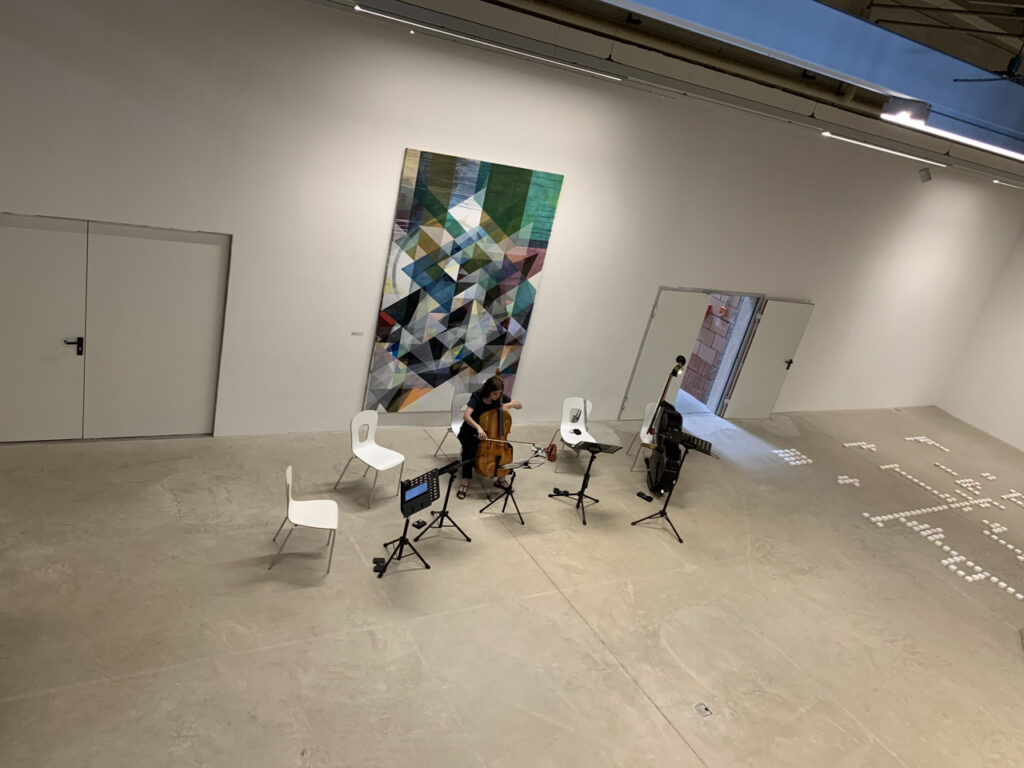
29/04/2021
Precarious Life
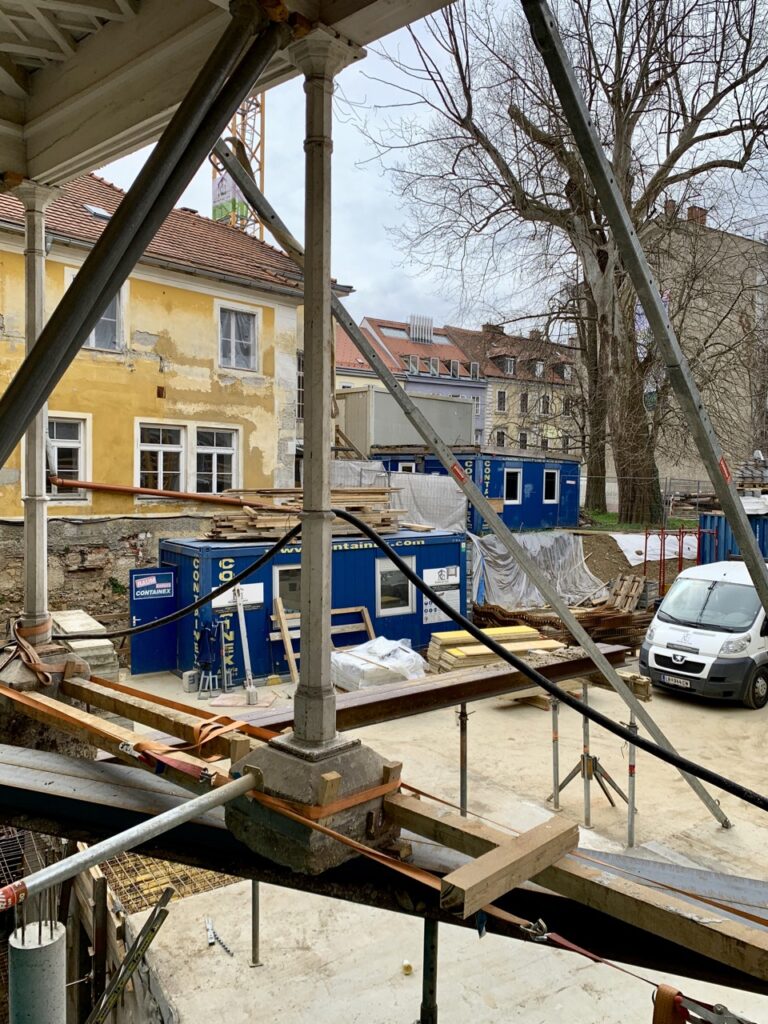
So much destruction and construction work going on. Walking through Vienna or Graz, I negotiate building sites, fences, obstructions while trying to avoid clouds of dust and noise. I notice an increasing brutality in how remnants of older buildings are being handled, and, at the same time, trees and patches of nature are protected in absurdly unrealistic ways. Does anybody pay attention to nature’s needs? In Graz, I go to fetch a key from the infrastructure department of the university. That office is situated in a century old building surrounded by a garden, with a group of magnificent, huge trees. The garden is all gone now: right around the historic house, a deep pit had been excavated. A small bridge patched together from planks leads across the pit and along the building, to the entrance. The delicate wooden balcony over the gate is suspended in mid air by a makeshift framework. There is nothing underneath my feet, no earth anymore, dry ground and concrete somewhere deep down. The old trees remain, preserved on a green island standing out from the bottom of the pit, so small that I wonder how their roots can hold on. The new living quarters already condense around the baroque house. Staff from the university are working in there, in the middle of all that noise and dust and destruction. Judith Butler’s Precarious Life comes to my mind as I cross over the planks (Butler, 2004, p. 25): “It is important to claim that our bodies are in a sense our own and that we are entitled to claim rights of autonomy over our bodies.” Not only humans. I wish that the trees would be able to claim that – in such a way that humans could hear their voices. I follow the news about plans to acknowledge a river in New Zealand as a legal person.
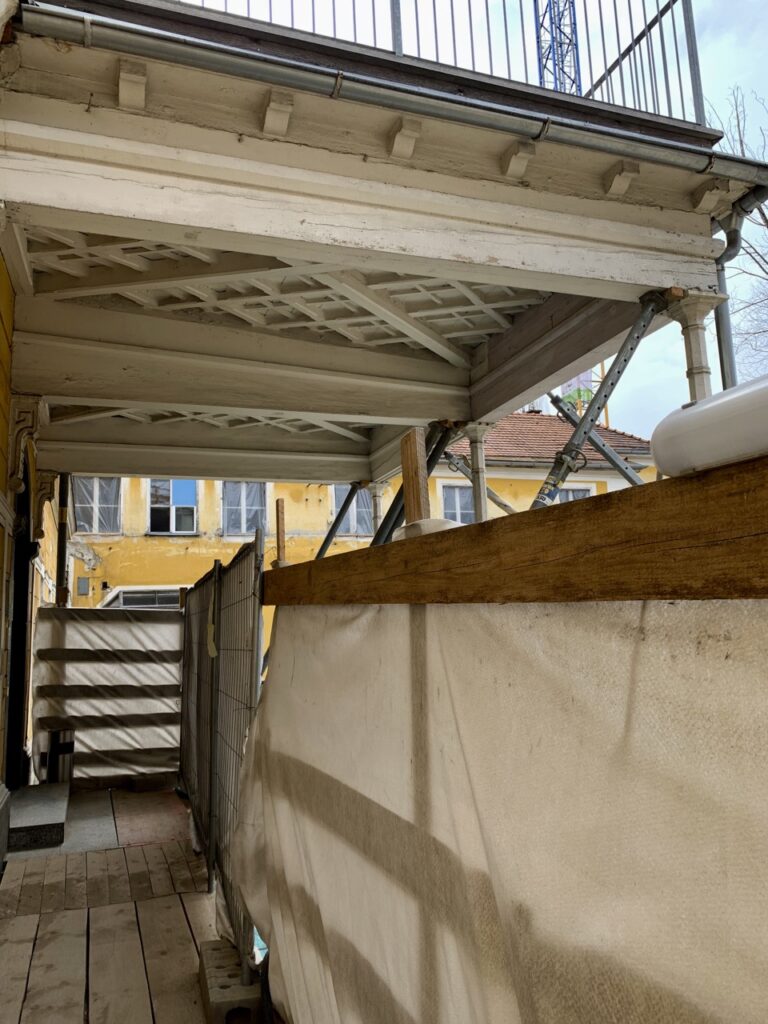
Another construction site in Vienna. A storm with heavy rain shakes a tree that is encased in a wooden box; it is fully blossoming. The crane driver selects and grabs small iron particles. I am struck by how precisely and patiently this work is being done.
14/01/2021
Writing performance
I experiment with writing, video and sound projections for a streaming performance. How can I bring movement, sound and image and my body (my hand) together, in a meaningful way? Multiple layers of movement can be composed in this mode, plus I can use my voice. I find it interesting to join space and sound in this polyphonic practice.
18/12/2020
Worte suchen, finden
Vieles ist zu beobachten, im Inneren und im beschränkten Draußen, während der Eingeschlossenheit der Pandemie. In Wien war es die letzten Wochen oft nebelig trüb, das kennen wir, das sind lokale Wetterphänomene im Donautal. Die frühe Dunkelheit fällt mir dieses Jahr besonders auf: war das immer schon so? An manchen Tagen komme ich erst hinaus, wenn es bereits finster geworden ist. Trotz der vielfältigen Eindrücke und trotz der bunten Schattierungen meiner sich in unregelmäßigen Zeitabständen ändernden Stimmungen finde ich kaum Worte dafür. Die Zustände sind mir bewußt, ich observiere alles durchaus aufmerksam. Es fällt mir jedoch schwer, das, was ich beobachte, verbal zu beschreiben. Wieso ist das der Fall? Macht das die Einsamkeit? Ja, ich fühle mich zunehmend einsam – obwohl ich täglich mit unterschiedlichen Menschen zu tun habe: sehr oft Online, aber schon auch in der realen Welt. Die Distanzierung auf der körperlichen Ebene macht mir zu schaffen.
Verliert sich meine Fähigkeit, zu kommunizieren? Ich schreibe viel, vor allem zahlreiche Mails in unterschiedliche Richtungen, ich schriebe text für dies und das. Scheinbar ist das etwas Anderes als einen Blog zu verfassen. Oder ist es wegen der Flüchtigkeit der persönlichen Erlebnisse? Fehlt die Verortung der Ereignisse? Gefühle und Gedanken kommen und gehen, sie sind bisweilen intensiv, drängend, und wechseln schnell die Farbe, den Geschmack. Ein wenig wirken sie wie die Steine in den Schaukästen der Mineraliensammlung, gestern. Die physische Dimension, die Ver-ortung, die Ver-Körperung leidet derzeit – die Ver-Köperung meiner Zuneigung zu bestimmten Menschen etwa: keine Umarmungen. Die Ersatz-Rituale bringen’s für mich nicht. Die Mineralien sind auch dis-loziert: ihre Anordnung in den Schaukästen ist menschengemacht, künstlich. Nebeneinander liegen sie nach Farben und Inhaltsstoffen angeordnet, aus der Umgebung gerissen. England neben Norwegen und Nordamerika.

Die letzten Einträge haben keine Überschriften, fällt mir auf. Ich nehme mir vor, diesen Blog im Nachhinein zu ergänzen. Die Lücke von einem Monat muss aufgefüllt werden, denn in der Zeit ist so viel passiert. Ich brauche Worte, ich möchte sie wieder finden.
17/12/2020
Farbenpracht

Mit Freund*innen bin ich im Naturhistorischen Museum. Die Idee, sich anläßlich des Geburtstags der Komponistin und Musikerin Susanne Kirchmayer im Museum zu treffen, kam gerade richtig. Wenn nichts anderes offen ist, ist ein Museum ein guter Ort: es gibt viel Raum, die Umgebung ist anregend, man kann sich bewegen, die Objekte anschauen, darüber und miteinander reden. Ich mag das NHM sehr. Diesmal war ich ein wenig enttäuscht, die Kästen wirken etwas vernachlässigt, hie und da wurden Schilder haarsträubend dilettantisch ergänzt, manche Schaukästen sind in Umbau – okay. Die Mineraliensammlung strahlt wie eh und je, die Farbkraft der Gesteine ist phänomenal. Steine regen mich an, über das Konzept des Lebens nachzudenken. Was ist ein biologischer Vorgang, was nicht? Was ist das Wachsen von Steinen gegenüber dem Wachsen eines Baumes?

09/11/2020
Die letzten Tage waren ein einziger Strom aus Arbeit, Proben mit nur teilweise besetzten Ensembles (weil die Corona-Quarantänebestimmungen ihren Tribut fordern), Neuorientierung, Diskussionen, Suche nach Lösungen. Heute im WUK kam dann durch die gemeinsame Arbeit im Raum Vieles zusammen. Im Tun findet man sich doch wieder, es waren heftige Gespräche vorausgegangen. Am Abend war der Tanzboden auf Holzplattformen montiert, das Membran-Zelt hängt, Licht und Ton sind gut aufgestellt und auch die Plätze und Instrumente sind für das Ensemble bereit. Der rote Tanzboden ist eine Augenweide. Morgen sind die ersten Tutti-Proben mit Juliet Fraser und Paola Bianchi. Beide sind angereist, trotz der widrigen Umstände.

#WienModern2020
#Wechselwirkung
#Stimmung
#fragilityofsounds
#Montage #Komponieren_im_Anthropozän
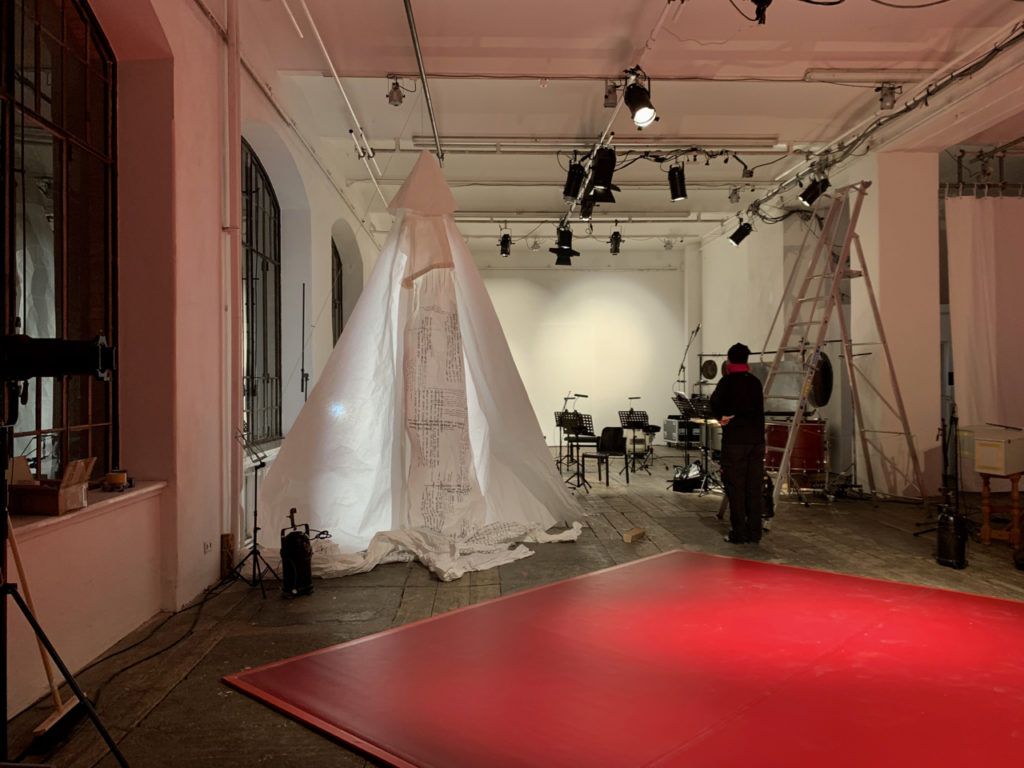
03/11/2020
Heute früh liegt ein horizontaler weißer Nebenschleier über der Stadt, wie ein See.

02/11/2020
Eine dunkle Nacht. Wien, du friedliche Stadt, jetzt eben ein Terroranschlag, immer noch nicht zu Ende. Was ist da geschieht mit uns. So viele Menschen wollten noch einmal raus, bevor um Mitternacht der zweite Lockdown beginnen wird und alle Lokale schließen. Ich denke an meine Freunde, Familie, tausche Nachrichten aus. Alle sind okay, zum Glück. Unruhe. Trauer, viel Wehmut. Schreck in den Knochen. Soviel auf einmal.
Gerade eben endete ein längeres Zoom-Gespräch mit meiner Mit-Forscherin Christina Lessiak und den Künstlerinnen Juliet und Paola. Wir bereden, wie wir weitermachen wollen nach der Absage von Wien Modern. Die Lage wird für uns zunehmend unüberschaubar. Paola erwartet demnächst verschärfte Regeln für einen Lockdown in Italien. Juliets Konzerte in Holland werden abgesagt, ihre Reisen storniert. Sie müßte direkt aus London anreisen, und nach der Arbeit in Wien in Quarantäne in England, da hilft auch kein negativer Test. Wir reden lange, spekulieren über mögliche Szenarien, tauschen unsere Gefühle und Ideen aus. Wir finden, dass wir müde werden. Soviel Gerede über Möglichkeiten und Unmöglichkeiten, ein ständiges Hin- und Her. Die andauernde emotionale Anspannung zollt ihren Tribut, die künstlerische Arbeit leidet. Wir finden keinen Entschluss und vertagen die Entscheidung auf ein neues Online-Treffen am Mittwoch.
Gerade noch habe ich, um Juliet und Paola zu beruhigen, gesagt: ich fühle mich in Wien sicher, die Menschen gehen großteils zivilisiert mit der Situation der Pandemie um, im Großen und Ganzen. In Gasthäusern, Cafés, bei Konzerten sowieso. Die Situation ist nicht so schlecht, scheint mir stabil. Jetzt das. Ich denke an die Leute, in den Lokalen im ersten Bezirk, in den Schanigärten rund um die alte Ruprechtskirche, an die Synagoge dort. Ein zentraler Platz, an dem viele täglich vorbeikommen. Der Ort ist mir so vertraut: die Reihe mit Neuer Musik in der Ruprechtskirche ist schon lange ein Fixpunkt der Szene, und ebenso das Restaurant daneben, wo wir nachher feiern. Ich habe die Pflastersteine am Platz gut im Gedächtnis, weil die Transportkästen dort immer so rumpeln beim Drüberziehen, auf dem Weg zum Aufbau in die Kirche.
Ereignisse schichten sich übereinander. Trauer fließt darüber. Gerade noch die Verzweiflung darüber, dass mein Stück nicht aufgeführt werden kann, und jetzt kippt das in den Hintergrund gegenüber dem Terror, der die Zivilgemeinschaft betrifft. Ich lese bis spät Nachrichten auf internationalen Webseiten und schlafe unruhig.
01/11/2020

Vorgestern noch im Konzerthaus, bei der Eröffnung von Wien Modern… Wehmut und Wertschätzung war zu spüren im Publikum, im Haus. Trotz der flammenden Rede Von Berhard Günther steht heute also fest: Wechselwirkung darf nicht vor Publikum aufgeführt werden. Es hat sich abgezeichnet in den letzten Tagen, die harte Tatsache selbst löst in mir dennoch eine Art Schock aus. Auf eine kurze, nahezu unheimliche Zeitspanne der Starre folgt eine Flut von Ideen. Ich bin still und immens erregt zugleich, es fühlt sich an wie Fieber – nicht Corona, nein, sondern Tatendrang in jedem zitternden Zellkern. Raus aus der Situation. Irgend etwas tun, etwas in Bewegung setzen (Sigmund Freud hat doch so einen Zustand beschrieben?).
Das Mobiltelefon läuft heute den ganzen Tag. Ich rede mit Kooperationspartner*innen, mit bereits bestehenden und mit potentiellen weiteren, für neue Aufgaben. Intendant Bernhard Günther meldet sich gleich in der Früh – höchste Zeit, finde ich, endlich und gut so. Wir sitzen schon länger auf Nadeln. Die Streaming Idee kommt ins Spiel – ich fühle mich nicht wohl dabei. Nicht schon wieder. Die Grundstimmung aller Mails, die ich heute austausche, und der Gespräche, die ich führe – mit Paola Bianchi, Juliet Fraser, mit Kolleg*innen wie Margarethe Maierhofer-Lischka und mit der Künstlerin Jade, mit Reinhard Fuchs oder mit der Theaterwissenschafterin Irene Lehmann ist: bitte nicht schon wieder Streaming. Das bringt’s (hier) nicht.
Eine Aufführung ohne Publikum ist keine Aufführung. Und erst recht nicht, wenn es sich dabei um Musiktheater handelt.
Eine Aufführung ohne Publikum gibt es nicht, was in so einem Fall stattfindet ist etwas anderes, dafür muss erst ein Wort gefunden werden. Die Herstellung eines Streams jedenfalls ist ein technischer und künstlerischer Mehraufwand, auch wenn’s ein einfacher ist. Es ist ein grundsätzlich anderes Format als eine Aufführung. Das Überangebot an Streaming ist im Fall von Musik oft von schlechter Qualität, verflacht, ödet mich grade eben in der Fülle an. Das immer gleiche Format in A4 Größe so cirka, auf meinem Laptop. Okay, manchmal scheint es besser funktionieren, ich meine für manche Genres, für mache Performances.
Der Aspekt der Gesellschaft, die zusammenkommt, fehlt mir dabei immer, und zwar schmerzlich. Margarethe bemerkt, dass grade eben eine Zweiklassen-Streaming-Gesellschaft in der Musik entsteht: die einen können sich’s leisten, teure Aufnahmen zu produzieren und zu verbreiten, die anderen, die sich das nicht leisten können. Künstler*innen werden ausgenützt, denn für ein Video ist seitens der Festivals und Plattformen kaum Geld da. Man kann oft nicht eine 1:1 gefilmte Aufführung ins Netz stellen. Ein Konzept, ein Drehbuch ist wichtig – und das braucht Zeit und Geld (siehe Musikfilm). Genau genommen ist/war das schon bei Tonaufnahmen so: eine gute Aufnahme verlangt ein klares Konzept. Danach muss mikrofoniert werden, das aufgenommene Material gemischt und gemastert werden. Zuletzt muss das Produkt ansprechend verbreitet werden; früher einmal war das ein Plattencover, eine Verpackung, das Design der Scheibe. Mit Filmen oder Streams ist es genauso. Und jemand muss – gekonnt bitte –die künstlerische Arbeit in der Musik, der Komposition, der Choreografie, mit dem Raum, mit den Körpern und Instrumenten und Stimmen zeitgemäß in ein anderes Medium übersetzen.

In diesen vielen Gesprächen komme ich zum Entschluss, die Aufführung von Wechselwirkung als Film darzustellen. Das Thema ‘Montage’ bekommt so mehr Tiefgang. Ich möchte alles dran setzen, diese Idee umzusetzen. Es ist die schlüssige Fortsetzung eines Projektes, an dem wir bereits drei Jahre arbeiten. Drei Jahre Arbeit an einer interdisziplinären Komposition mit mehreren Künstler*innen, und jetzt das. Ich möchte das erforderliche Geld auftreiben – mit Wien Modern gemeinsam. Im Sinne von Fair Pay. Wenn, dann ordentlich bezahlt und gut gemacht, mit genug Zeit.
Spät nachmittag komme ich dazu, einen Spaziergang im Regen zu machen. Dunkelheit und Nebel über Wien. Ich mag diese Stimmung, sie passt zu mir. Und wieder läutet das Telefon… ein Update ist fällig. Weiter gehen.

24/09/20
Urban serenade

installation by Molly McDolan
On one of the last pleasant evenings, at the end of summer I enjoyed a nocturnal serenade downtown Vienna. Lots of people were outside, the streets and the small park was crowded in the busy quarter around Schleifmühlgasse. The series Hasenherz, organised by curators Anderluh and Grond along a conception of Schönberg, presented one of their musical events in the open air. Oboists Molly McDolan and Ana Inés performed Eins & Doppelt twice, with an artists talk in between and a short lecture beforehand. People asked all kinds of interesting questions about the music and the instruments. What a treat! The performance was a premiere, actually, because the piece was performed in a forest for the first time – in April this year, during the lockdown. Only animals and plants had listened then, and a fews hikers coming by.


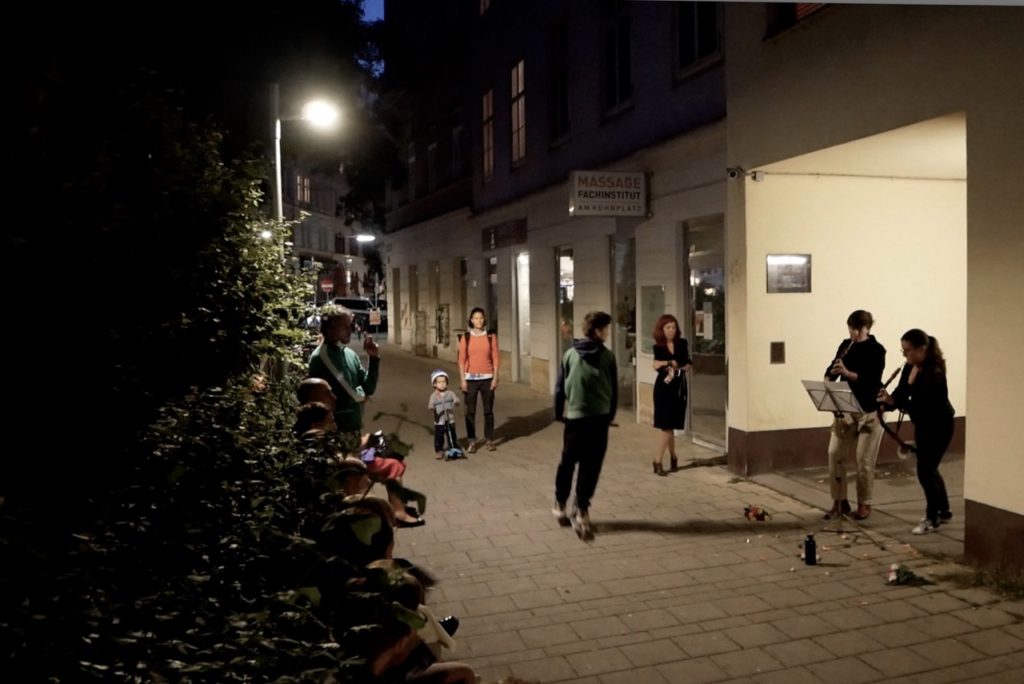
Outdoor concerts turned into a habit this summer, as the best way to stay connected to live music. In a discussion after the concert, we came to the conclusion that all of us quite vividly remember every outdoor event we visited since the lockdown. We were actually surprised to find out that memories of recent outdoor concerts were preserved in particularly brilliant and vivid conditions. Outside, music performances might acoustically suffer from the surroundings: a sudden gust of wind can damp instruments, or noise from a nearby street can mask the sound. Nevertheless, we seem to remember the concerts well. I think that the reason for this can be the multiple sensory input that is generated by the outdoor situation. The smell and temperature, the wind and the sky above, the movements and rustle in trees and plants enrich the sensory impact. They surround the music we listen to…. there is so much to gather from an outdoor environment. The array of environmental perceptions helps to anchor the content we store in our minds, and becomes a thick golden frame, like something we put around an old painting, to enhance and present it in splendid condition.
The event was hosted by the small gallery 12-14 contemporary nearby in Schleifmühlgasse. Here, Molly McDolan’s installation can be seen, featuring my video Forest #1.

13/09/20 Vienna
Wechselwirkung.
Ein weiterer Proben– und Forschungsprozess.
Bei den Proben im September erlebe ich den kollektiven Prozess als ungewohnt körperlich, intim und persönlich. Es fällt mir schwer, Protokoll zu führen oder Notizen zu machen, so wie ich es geplant hatte. Wir halten Distanz voneinander, weil uns bewußt ist, daß es derzeit mit großen Schwierigkeiten verbunden ist, als Künstler*in zu reisen und professionell zu arbeiten. Als kleines, internationales Team spüren wir die direkten Auswirkungen der Vorschriften, die während der Pandemie zu befolgen sind. Die Vorkehrungen fressen nicht nur Zeit und Achtsamkeit. Vor allem binden sie emotionale Energie. Wir müssen als Gruppe ständig neue Entscheidungen fällen. Noch am Abend vor Probenbeginn beschließen wir, dass die Musikologin Christina Lessiak nicht in Wien teilnehmen wird, sondern in Graz in Quarantäne bleibt. Im Büro ihres Freundes trat ein Coronafall auf, der Wellen schlägt. Wir planen daher um. Die Choreografin Paola Bianchi wird auch nicht bei mir wohnen, sondern allein in der leeren Wohnung eines Bekannten. Ihr scheint das Risiko, in meinem Zweipersonen-Haushalt mit vielen Außenkontakten zu übernachten, zu groß. Sie müßte daheim in Italien länger in Quarantäne, falls jemand in ihrer Umgebung positiv getestet würde. Die neuen Umgangsformen machen mich persönlich kribbelig, ärgerlich und rastlos: meine Haut ist anscheinend dünner als sonst. Ich erlebe mich besonders abends als ungeduldig. Öfter als sonst fühle ich mich gereizt von Mitmenschen im Alltag und schnauze fremde Leute an, in Situationen, wo ich üblicherweise doch ruhig bleiben würde. Ich kenne mich so nicht. Fehlt mir denn die körperliche Nähe als solche, als beruhigender Faktor, in meinem Sozialleben? Ja, ich bin mir sicher, daß es genau das ist – ich hätte es nicht erwartet, aber ich kann mir meine gegenwärtige Stimmung nicht anders erklären.

Auf der künstlerischen Ebene entwickelt sich das Projekt gut. Der kollaborative Prozess wird tiefer, sowohl im im Bereich der Bewegung als auch in der Musik. Ich beobachte, offen und doch kritisch, bin neugierig. Im Proberaum ist mir trotz – oder gerade wegen? – der größeren physischen Distanz alles zu nah. Meine Gefühlsebene scheint durcheinander gewirbelt. Ich nehme Juliet Fraser und Paola Bianchi dabei wahr, wie sie sich bewegen, wie sie Körper bzw. Stimme einsetzen, während sie die Choreographie und Komposition des Stücks zu erarbeiten. Während ich als Komponistin zuhöre, anleite oder kommentiere, bin bin körperlich berührt davon, Juliets Stimme zu hören. Ich erlebe intensiv, wie konzentriert sie als Sängerin und professionelle Performerin an einer körperliche Präsenz bei der tänzerischen Bewegung arbeitet. Zeitgenössischer Tanz ist für sie ungewohntes Terrain. Ich beobachte: wenn Juliet Fraser sich bewegt, ohne zu singen, wirkt sie als Performende für mich in anderer Weise präsent als beim Singen. Beim Singen wirkt sie vertraut. Wenn Juliet Fraser tanzend mit der Choreographie experimentiert, fühlt es sich für mich fremdartig und intim an, sie dabei zu beobachten – nahezu voyeuristisch. Empfindet das ein Regisseur beim Film auch, frage ich mich? Vielleicht kommt es daher, dass Tanzen an sich eine unvermittelt körperliche Form der Manifestation ist? Oder, weil das Singen ein für uns gewohnter Vorgang ist, ein körperlicher Vorgang, mit der wir als Musikschaffende vertraut sind – wohingegen der Tanz das ‘Andere’ ist?
20/08/2020 Poschiavo, CH
Stimmung


[ein Text für Wien Modern]
Das Wort ‘Stimmung’ ist mir wichtig, weil es ein Hörvokabel ist – es deutet darauf hin, dass die Welt als Ganzes hörbar ist und mit den Ohren durchmessen werden kann. Nach dem Aufruf der Komponistin und Hörforscherin Pauline Oliveros – “auralize the sonosphere” – sammle ich Hörvokabel, um sie bewußt einzusetzen. Anders als Begriffe wie etwa Ausblick, Einsicht, Perspektive, Anschauung oder Blickwinkel, die sämtlich von einer Kultur des Sehens geprägt sind, klingen in einer Stimmung vielschichtige Erfahrungen wieder, wie sie eben nur die Ohren wahrnehmen können. Denn ich höre nach Außen und erschließe eine menschliche und nicht-menschliche Umgebung, während ich hinein, in mein Inneres, lausche und Reaktionen, Gefühle oder Gedanken bemerke. Ich kann gar nicht anders, denn das Hören läßt sich nicht verhindern, weder in die eine noch in die andere Richtung. Der Hörsinn entgrenzt mich. Als Horchende bin ich ausgeliefert, offen und fragil – und zugleich höchst präzise und gestaltend tätig. Jede Stimmung ist das Ergebnis eines fein abgestimmten Vorgangs, der das Äußere mit dem Inneren in Einklang bringt. Jede Stimmung ist eine individuell komponierte Polyphonie, denn sie notiert das Persönliche zugleich mit der Umwelt. Jede Stimmung dokumentiert die Hörbarkeit der Welt auf einzigartige Weise.
Hiking to the historic chapel San Romerio high up on a mountain plateau overlooking the valley, Cornelia Müller and I are caught by a severe thunderstorm. Rain, thick fog, wind and clouds change quickly, and our mood as well. What a theatre of Stimmungen, a theatre of weather and lighting. Patches of fog rise up vertically, from the bottom of the valley. San Romerio is a very special place. The small stone chapel, over 1000 years old, sits right on the edge of a steep cliff, offering a wide view down to the lake and to the villages below, and far over mountain ranges towards Italy. Within an hour, the storm went by and the sky became brilliantly clear again. We can continue on our path.

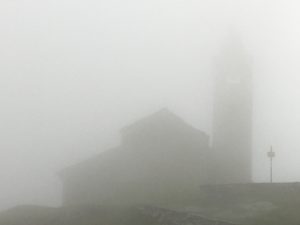


15/08/2020 Poschiavo, CH
Barocke Räume

Ich spiele im Oratorio Santa Anna, einer hohen, barocken Kapelle in Poschiavo. Der Raum hat mir sofort gefallen, als ich ihn das erste Mal betreten habe. Spontan hatte ich den Wunsch, hier zu improvisieren, die Akustik ist vielversprechend. Schnell war eine kleine Konzertreihe organisiert: jeden Mittwoch nachmittag im August mache ich bei offenem Kirchentor eine Stunde Musik. Dabei unterbreche ich Solowerke von J. S. Bach mit Improvisationen… oder reichere sie an, oder verwebe beides. Ich habe schon länger keinen Bach mehr öffentlich gespielt; der Plan funktioniert gut. An ausgesuchten Stellen unterbreche ich Bach, plötzlich oder ich friere den eben gespielten Klang ein, oder wiederhole eine kurze Phrase mehrmals, und springe von hier in eine andere Dimension, in meine heutige Improvisationswelt. Manchmal nehme ich dabei etwas mit von Bach – eine Textur, oder Rhythmen, Tonhöhen, einen Flow, eine Erinnerung an Akkorde aus dem Hintergrund, ein Intervall, eine Bewegung – oder gar nichts. Dann verlasse ich Bach und wende mich in eine andere Richtung. An welchen Stellen jeweils findet ein Schnitt statt? Während ich spiele, beobachte ich, wie ich diese Entscheidung fälle.

Es gibt Stellen, die ich als durchlässig empfinde, wo sich etwas zu öffnen scheint in der Musik, zwischen zwei Klängen, oder in der Bewegung von einem Klang zum anderen, oder innerhalb eines Klanges, mittendrin. Oft wähle ich Schwerpunkte von Bach und schneide genau dort; oder es interessiert mich eine Bewegung in der Musik so sehr, dass ich halten möchte, und genau dort bleiben und tiefer gehen. Ich untersuche die jeweilige Stelle dann in der Improvisation. Ich lasse mich hinein fallen in ein Terrain, das ich beim Improvisieren erschließe. Als ob die Zeit still stünde in einem Klang oder in einer Klangtextur und ich durch den Klang hindurch in eine andere Dimension des Seins gelangen könnte.
Ich schlüpfe
durch ein Tor
in eine musikalische Parallelwelt. Oder ist es ein Zeitsprung?
Das Tor von Santa Anna ist rundum geschmückt mit ausgebleichten Totenschädeln. Man muss durch die vielen Knochen durchgehen, um in den hellen, prachtvollen Innenraum zu gelangen. Ich mag diesen Eingang sehr, genieße die dunkle, gnadenlos gerasterte Struktur dieses Tores. Gerade jetzt, in der Pandemie… hier und jetzt Grenzen durchschreiten. Ich stelle meine Performances in einen doppelten barocken Raum: in den Kirchenraum als architektonischen Raum, und in den Zeit-Klang-Raum von Bachs Musik. Diese beiden Räume bilden einen starken Rahmen für meine Musik.



Bei diesen Performances kann das Publikum kommen und gehen – das ist in Zeiten von Corona einfacher zu organisieren als ein formales Konzert. Manchmal sind viele Leute mit mir im Raum, dann wieder ist er leer bis auf eine Person. Ist Klang ohne Publikum etwas anderes als Musik? Wer definiert Musik? Ich habe als Musikerin viel ‘allein’ gespielt oder geübt, als Kind in der Natur mit der kleinen Flöte, später in unterschiedlichen Räumen, in leeren Kirchen, Fabriken, zu Hause oder in Studios, oder im Wald, oder nachts in leeren Hallen. Meine Erfahrung dabei ist: wo immer Raum ist, gibt es auch Zuhörerschaft. Menschliche oder nicht-menschliche. Es war mir stets bewußt, dass ich nie ‘allein’ bin: es gibt stets Tiere, zumindest Insekten, Pflanzen… manchmal sogar Menschen, dort, wo ich keine vermuten würde. Der gesamte Raum, in dem ich mich befinde, vibriert, wenn ich spiele… mit allem was da ist, sei es im Freien oder in einem Gebilde oder Gebäude.

An dieser Stelle finde ich einen Gedanken interessant, wie ihn J. S. Bach ausdrückte, indem er über seine Kompositionen das Kürzel schrieb: SDG (Soli Deo Gloria). Das bedeutet: diese Musik ist komponiert für etwas noch ganz anderes als die materielle oder menschliche Dimension. Für etwas, was über das Menschliche oder Lebendige oder Materie hinaus geht. Persönlich würde ich das anders ausdrücken als Bach, ich bin nicht religiös. Ich denke mehr mit Pauline Oliveros, aber in dieselbe Richtung: jede Schwingung trägt zur ‘Sonosphäre’ bei. Ich würde schreiben: für die Vollständigkeit oder Schönheit der Sonosphäre, oder für das Wohl des Planeten komponiert, oder für das Weltall, was auch immer da ist außen. Die Sonosphäre wird beeinflusst von allem, was klingt. Stets finden Interferenzen statt, seit dem Urknall. Es sind rein akustische Sachverhalte, die ich hier anspreche, keine Metaphysik.

10/08/2020 Poschiavo, CH
[A text written for the composition Wechselwirkung]
Lasciatemi qui sola She sings Leave me here alone Leave me to die alone Keep your distance At all costs Lasciatemi mori Altri meco non voglio Look Sweet flowers of spring Listen Birds sing Tornante Turn around When you meet me on the street Don’t look at me Hide! Turn around! Altri meco non voglio Veil your sweet lips I cannot enjoy any more Hushed souds Echo in empty streets Go sing your songs elsewhere Dolcissime sirene Leave me to die Lasciate mi mori Tornante! Be welcome Sweet death Analogue lover Remain with me I adore your Smell of darkness Of damp earth No more Streaming online Bodyless No more sailing without form Searching for love In vvvvain Hold me tight in your arms Closer! Let me feel your cold embrace When I collapse into A single Lonely dot Immaculate skies Day and night Above Pure longing [In this text, I use some Italian sentences from Francesca Caccini]
05/08/20 Poschiavo, CH
Artist in Residence @UNCOOL Poschiavo, CH

This is my living-working room during August, in an old house in Southern Switzerland, close to Italy. Most older houses in the valley have this kind of complete wooden interior. The feeling in the house is nice and comfortable. The invitation to the residency in Poschiavo came as a surprise, at the right time: curator Cornelia Müller called in June and offered the place to me; I immediately agreed to come. With the Corona-crisis evolving over the next weeks, travel conditions were uncertain, but in the end everything worked out. It was a wonderful place to work, perform, and enjoy nature. Cool temperatures and fresh air included. Thanks so much for hosting me!


09/04/20
Komposthelden kommen aus dem Dorf.
Wirre Gedanken in der Krise.
Heute Nachmittag, Online-Diskurs mit zwei Kolleginnen. Wien/Hamburg/Graz im lebhaften Gespräch, Gedanken kreisen quer durch die Themen Krise, Musik, Theater, Politik, Gender und Interferenzen – letzteres ist seit ein paar Monaten eins der wichtigsten Themen für mich. Seit dem Lockdown merke ich, wie sehr Interferenzen relevant sind, weil spürbar ist, wie alles zusammen hängt, und am eigenen Leib noch dazu. Wir drei finden, manches wird grad so retro, man kann in der Politik einen Zug ins Traditionelle spüren, teilweise auch in der Kunst, so wie sie sich derzeit manifestiert. Oder bei den Gebieten Gender und Pflege. Geht man da einen Schritt zurück?
Held ist auch so ein altbackener Begriff, finde ich. Der ist aber jetzt in aller Munde. Helden in der Krise werden gefeiert, beklatscht, beschrieben, die Gesellschaft suche doch Helden, es häufen sich Politiker*innen, die als Helden auftreten (wollen). Wenn man zurückschaut in der Geschichte, wie wurden große humanitäre Krisen bewältigt? Ist es nicht so, dass es meist nicht einzelne Menschen waren, sondern viele Kräfte zusammen, die eine Wende bewirkt haben? Okay, Jeanne D’Arc, Spartacus oder Wilhelm Tell waren herausragende Figuren. Oder die in der Bibel. Ich will aber nicht über Kriege oder Religionen reden; Kriege und Religionen sind doch stark vertikal organisiert, die oben bestimmen, unten wird gestorben oder gebetet, Kriege sind menschengemacht, da steckt Kalkül dahinter. Naturereignisse, komplexere Katastrophen. Wie war das bei der Pest – den Pestausbrüchen, es waren viele – oder der Spanischen Grippe? Oder mit der Widerstandsbewegung gegen das Naziregime? Hungersnöte? Vulkanausbrüche? Erdbeben? Überflutungen? Wer hat da an der Rettung gearbeitet? Ihre Namen kennt man vielfach gar nicht. Viele Frauen, viel Pflegearbeit. Je mehr geforscht wird, desto mehr einzelne Personen kommen ans Licht, die unglaublich zuversichtlich und helfend handelten, im Hintergrund oft, aber wirkmächtig. Siehe Widerstandsbewegung gegen das Naziregime: immer noch werden neue Personen entdeckt, die mutig waren und aktiv im Bemühen, Leid zu lindern und eine Entwicklung anders zu drehen. Der Held hingegen ist eine Gestalt aus der europäischen antiken Sage, oder aus dem Mittelalter. Manchmal ist er ein Konglomerat, wie Herkules oder Odysseus: unterschiedliche Erzählungen werden zusammengemischt und einer fiktiv angereicherten Figur zugesprochen. Frankensteinhelden. Komposthelden.
Aus der Nähe betrachtet, vermute ich, sind die antiken Helden wohl als regionale Figuren entstanden. Sehr lokal. Ich stelle mir das so vor: jemand hat im Raum der unmittelbaren Umgebung oder Siedlung etwas getan, was dort wirksam war und gut ankam. Ein großes Wildschwein erlegt. Local hero. Das ist weiter erzählt worden, im Nachbarort, und weiter, und weiter. Den Wanderwegen ist die mündliche Überlieferung gefolgt (wie ein anteckendes Virus). Erst kleinräumig, wie eben in Dorfkulturen geredet und weitererzählt wird, oder in einer Festung, und langsam gewachsen, die Story war gut, fand Anklang. Superspreader. Brauchen wir im digitalen Zeitalter noch eine Dorfberühmtheit? Der Held ist ein Produkt, eine Modellfigur einer dörflichen Denk- und Kommunikationsstruktur. Dort soll sie auch bleiben. Wir kommunizieren anders, jetzt grad, wir drei, und wir alle.
04/04/20
Trockenheit

Ich gehe oft spazieren, muß hinaus, brauche den größeren Raum. Der Frühling fühlt sich intensiv an, der Wald ist überdurchschnittlich trocken. Wer beachtet das Klima jetzt? Es hängt mit der Krise zusammen.
26/03/20
Online communication #interferences
My days at home are punctured by video conferencing. Musicians, composers, performers, and researchers are exceptionally busy all over the world, trying their best to accommodate to the situation and to restructure their lives and modes of working accordingly. Because of time-differences, online meetings can happen at odd times. Video conferencing makes me tired, I find I need a lot of energy for this kind of communication. On the one hand, communication via internet lacks in directness. The technical work surfaces we use have a life of their own, the quality of internet connections and surrounding media define our exchange.
Once more, I recall Donald W. Winnicott’s ideas of the Third Space as model of how human communication functions: a transitory zone opens up when people communicate with each other, a zone that extends beyond one’s personal sphere. Now, in video conversations, I experience that the Third Space between myself and my partners in conversation is infiltrated and filtered by the media surface. Interferences constantly happen. We have to balance media interferences while communicating. For instrumentalists, this becomes a severe handicap at the moment. With my colleagues, I discuss this topic. Evidently, the finer and more subtle qualities of instrumental performance cannot be transmitted through streaming, at least not via home-office situations.
Last Monday, I took this picture during an online performance of Pauline Oliveros’ scores together with 80 people from all over, organised by the ICE ensemble. Great experience, in spite of mediocre sound quality. Fond memories of Pauline with her accordion.
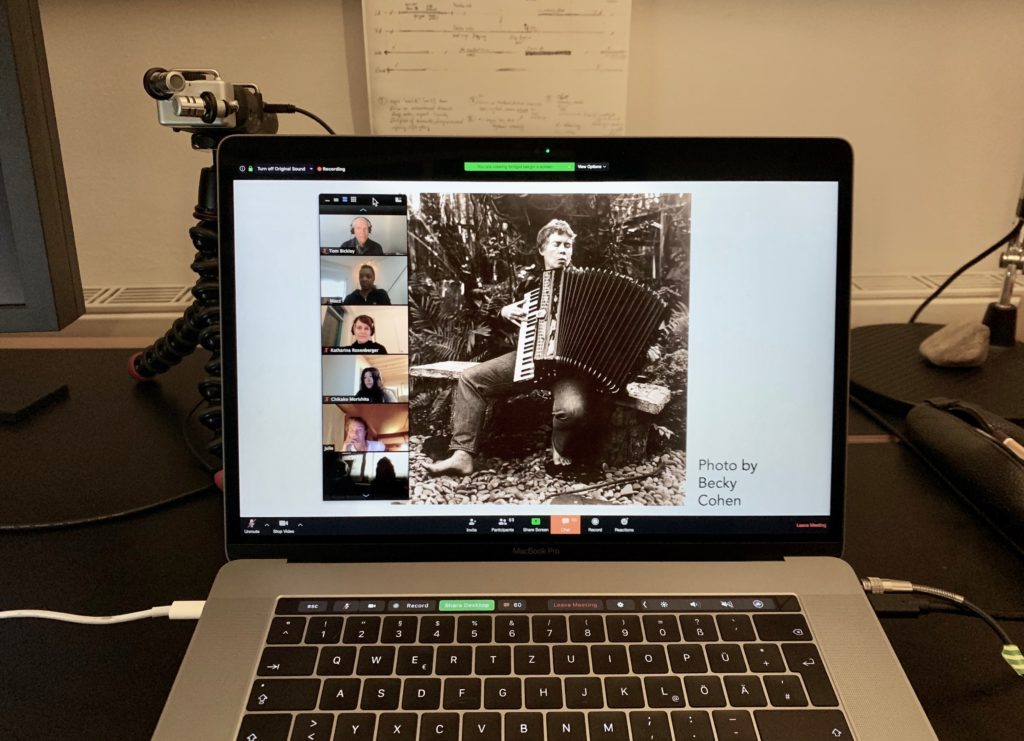
24/03/20
In the city of the blind
Take the pencil
Erase what you wrote
And take the pencil again
Please concentrate
Don’t be carried away by government regulations
Nobody understands
We all are blind
In the city of the blind
But the red wine still warms my heart and my head
To compose
You were so confident
You liked to fight and argue
You liked to be the angry woman
And now you are lost like everyone else
I will write about the warmth
As long as I can type
Mind!
23/03/20
Kultur ist
#gesellschaftshaltend
#versorgungskritisch
#Grundbedürfnis
#lebenserhaltend
Kultur & Terminologie.
Weltweit experimentieren.
Derzeit werden bestimmte Berufe und Arbeiten in Österreich, Schweiz und Deutschland als systemerhaltend bezeichnet. Diese Tätigkeiten haben in der aktuellen Gesetzgebung zur Regelung von sozialen Kontakten rund um das Corona-Virus eine besondere Stellung. Die genaue Bezeichnung variiert: zum Beispiel verwendet das österreichische Covid-Gesetzblatt das Wort versorgungskritisch. Auf derselben Seite ist im Erklärungstext die Rede von Grundbedürfnissen des menschlichen Lebens [siehe dazu die Webseite des Österreichischen Sozialministeriums].
Die Kulturwissenschafterin Dr. Ursula Baatz schlägt alternativ den Begriff lebenserhaltend vor. Welches System wird erhalten, welches System wollen wir erhalten? Mit ihr diskutiere ich die Stellung der Kultur und Kunst in der Corona-Gesellschaft. Wir sind uns einig darüber, dass Kultur und Leben stets untrennbar verbunden sind, und das gilt auch derzeit, im gesellschaftlichen Lockdown. Kultur findet immer, und gerade jetzt statt – allerdings nicht in gewohnter Form. Alle Konzerthäuser, Theater, Museen, Venues im Land (in Europa) werden geschlossen. Statt in der Öffentlichkeit entsteht Kunst und Kultur daher einzeln und meist in privaten Räumen. In der öffentlichen und persönlichen Wahrnehmung ändert sich gerade viel. Die Freie Szene ist hochaktiv. Menschen reden und diskutieren weltweit übers Netz miteinander, was derzeit in ihrem jeweiligen Umfeld passiert. Präzise Beobachtungen werden ausgetauscht und untersucht. In diesem Moment leben Menschen Kultur. Es ist eine Art von künstlerischer Forschung, die da soeben auf einer globalen Ebene stattfindet. Ein globales Experiment ist im Gang, ich fühle mich als Teil davon. Obwohl ich zu Hause bleibe, bin ich mehr denn je mit der Welt verbunden.
Die Untrennbarkeit von Kultur und Gesellschaft:
Kultur ist kein Ding oder Gut oder Objekt, Kultur ist fortlaufende Handlung und Tätigkeit.
Kultur kann man weder konsumieren noch besitzen, Kultur wird immer neu gemacht und neu verhandelt.
Kultur ist, was von vielen Menschen gleichzeitig getan wird. Was von einer Gesellschaft gleichzeitig getan wird.
Kultur ist Leben als Gesellschaft, in Gemeinschaft.
Kultur ist die Gestalt einer Gesellschaft.
Jede Gesellschaft erzeugt fortwährend ihre eigene Kultur.
Kultur und Gesellschaft entstehen gleichzeitig.
Menschliches Leben und Kultur entstehen gleichzeitig.
Es gibt keine Gesellschaft ohne ihre eigene Kultur.
22/03/20
Stimmungen.

Stimmung 5
Ich schreib grad viel. Ob alles wirklich geschrieben werden muss? Ist es die Zeit jetzt? Ich kann’s ja wieder löschen.
Stimmung 6
Ich mag das Wort ‘Krise’ nicht verwenden. Ein Virus gehört zur Natur so wie wir. Die Natur ist keine ‘Krise’, ein Virus macht keine ‘Krise’. Das Virus ist ein Naturphänomen.
Stimmung 7
Trotz der Kälte mache ein längere Wanderung an der Grenze von Wien und Klosterneuburg. Ich suche ruhige Wege, wo weniger Leute gehen, ich möchte nicht vielen Personen begegnen. Erstaunlich, ich entdecke heute einen Weg, den ich noch nicht kannte! Einen schönen, langen Weg mit feinen Ausblicken. Ein paar Menschen kommen mir doch entgegen; die Atmosphäre ist freundlich, wir grüßen einander, der Augenkontakt ist jedesmal direkt und warmherzig. Mit einer Familie und zwei Kindern plaudere ich auf Distanz über die Vorzüge einer aus Holz gebastelten Spielzeugaxt und über Ungeheuer im Wald. Mein Bedürfnis, hinaus zu gehen, ist groß. Ich bin froh, dass es diesen Wald gibt.
20/03/2020
Stimmungen.
Notizen zu einem Skype-Gespräch mit Irene Lehmann.
Stimmung 1
Es fällt mir nicht leicht, mich zu konzentrieren. Eine Melancholie und dunkle Stille legt sich über der Stadt. Meine Wehmut (es ist meine) betrifft alle die Dinge, die es jetzt nicht mehr gibt: die Dinge des öffentlichen Lebens. Seit Beginn des Corona-Lockdown in Österreich Anfang der Woche führte ich zahlreiche Gespräche mit Kolleg_innen, Künstler_innen und Forscher_innen, in Wien, Graz, weltweit. Ich hörte unterschiedliche Berichte darüber, wie quer durch die Welt reisten, um rechtzeitig wieder “nach Hause” zu kommen, bevor internationale Grenzen unpassierbar wurden. Nicht wenige dieser Menschen leben multinational und haben Ankerpunkte in unterschiedlichen Städten; sie haben eine Entscheidung gefällt, wo sie die nächsten Wochen – oder doch Monate? – verbringen werden.
Stimmung 2
Heute, Freitag, spreche ich mit Irene Lehmann, Theaterwissenschafterin und Forscherin im Bereich Performance und Musik. In regelmäßigen Abständen tauschen wir uns aus, reden über unsere jeweilige Arbeit, über aktuelle Erfahrungen und Wahrnehmungen und analysieren diese gemeinsam. Irene hat sich zwischen Hamburg und Berlin entschieden, auch sie pendelt regelmäßig. Hauptthema war der Wegfall an Aufführungen, Konzerten, Performances. Ich kann mich nicht so einfach für den digitalen Raum erwärmen. Es funktioniert für mich nur bedingt. Irene meint, ja, das ist wie beim Fussball: keiner möchte vor leeren Rängen spielen, es fehlt die richtige Stimmung. Irene verwendet das Wort Stimmung. Ich frage, was sie damit genau meint. Sie meint, ihre Freundin beschreibt die Stimmung draußen als aggressiv. Sie verwendet den Terminus Vernunftpanik. Ich erwidere, in Wien kommen mir die Menschen, denen ich draußen begegne, eher verschlossen und gedrückt vor. Viele halten den Blick gesenkt, wirken in sich gekehrt. Die empfohlene Entfernung von 1,5m scheint sich auf den Blick auszuwirken. Können Augenblicke anstecken? Es ist, als ob mit der Entfernung jede Art von Kommunikation und Wärme verboten wäre.
Stimmung 3
Wie ist das mit der Körperlichkeit? Geht das nur mir ab? Können junge Leute einfacher im digitalen Raum zu Hause sein? Ich beobachte von meinem Balkon aus ein paar Jugendliche auf der Straße. Es ist richtig warm draußen heute. Zwei junge Frauen haben sich in den Vorgarten gesetzt und essen gemeinsam, aber in etwas Entfernung. Zwei andere Jugendliche stehen ebenso da und sind mit ihren Mobiltelefonen beschäftigt. Diesen jungen Menschen die körperliche Nähe offensichtlich ebenso wichtig, trotz ihrer digitalen Anbindung. Sie gehen aus den Wohnungen auf die Straße, damit sie einander begegnen, wenn auch mit Sicherheitsabstand. Die Szene wirkt friedlich, Körper im Raum. Sie reden kaum miteinander. Körperlichkeit hat nichts mit dem Alter, Generation oder digitalen Gewohnheiten zu tun. Sie ist ein Grundbedürfnis. Ein Konzert klingt anders, wenn man es mit Jogginghose am gewohnten Sofa zu Hause hört, oder – in derselben Jogginghose, dann aber bewußt angezogen – in einem Raum mit 20, 200, 2000 anderen Menschen. Das Publikum leistet etwas für eine Veranstaltung, es bringt etwas mit.
Die Raumwahrnehmung verschiebt sich bei einer Aufführung mit Publikum.
Stimmung 4
Wir reden wieder über Interferenzen. Man kann grad nichts mehr auseinanderhalten. Man wird von allem gestört. Alle Parameter sind auf einmal anders. Der Wegfall der Koordinaten belastet emotional. Man wird leicht müde.
19/03/2020
#interferences #wechselwirkung
I don’t want to continue as before. Not now. Not at this time. I don’t want to compromise as composer. My sensitivity does not allow me to give in and carry on with business as usual. I don’t want to crank up some spirit of continuity when a giant NO is written across the empty streets and cities around the world. I tremble with the spirit of defiance. Interferences, that’s the topic I have brought up again and again in recent discussions with Irene Lehmann and Christina Lessiak, and it was the theme for experimentation with Paola Bianchi and Juliet Fraser. I cannot pretend to be whole any more, I am so connected to this planet. Interferences happen all the time. Something interferes with my life, I interfere with everything else. I am entangled in a global mess. The world enters, crosses over my doorstep, penetrates my skin. Everything interacts with everything else. No borders any more.

15/03/20
Before shutdown
The afternoon before shutdown in Austria: brilliant weather with a fresh wind and bright sunshine. Spring is in the air, trees and bushes begin to wake up. I go for a walk with my partner, my sister in law and her husband. We meet on a ridge in the hills outside Vienna. When greeting each other, we keep an unusual distance between us – the corona distance. Immediately, we begin to discuss physical distance. My brother in law thinks it’s a bit overdone. I feel it’s okay not to come closer, this time. We talk about body contact, and how we think the virus spreads, or how not, about what we know and don’t know. There is so much we don’t know, in spite of all the information around. People get their informations through different channels, and react differently. On this day, the idea of taking a walk in ‘distant’ company of friends outside brings joy, it feels like a touch of freedom. In a few hours, we are not allowed to spend time outside in company any more, only with people whom we live with. If one lives alone, that’s it. Unthinkable? For how long? To me, it feels like something old ends and something new begins. The afternoon tastes like irrevocability. The New is, at the moment, not known yet. Before the New, there is a field of involuntary enclosure everyone has to cross, a grey zone, a tight retreat situation that we are forced into, together, but as individuals. When composing, writing, or researching, I’m used to working by myself, at my desk in my work studio. I also remember how, during my long period as Buddhist practitioner before 2000, I conducted single retreats in my own apartment in Vienna. I locked myself in for a week or two and meditated following a fixed schedule, from morning to evening, without leaving the house and without talking to anyone, no messaging either. Some cooking and eating, yes, I felt I did not need much during those times. Then, I practiced how to come to friends with what I experienced. I learned to stretch the space within my mind and heart so that it would be big enough to accommodate all the wild facets and textures and surprising manifestations roaming therein.
Now, this is different: the external urgency is new. The virus and the falling apart of familiar structures and habits. In my lifetime, this city where I live has never been closed down, not to such a complete extent. No schools, no universities, no concert hall, no opera house, no theatre, no religious gatherings, no shops, nothing open except what’s absolutely necessary to keep up daily life. The famous Wiener Riesenrad, a distinct feature of the Viennese skyline at night, is not lighted any more. No walking in parks, no cafes, no restaurants, a giant NO written across all public spaces and gatherings of humans. How long will that be? I expect month, until fall. Nature remains the same, trees begin to push forth their new leaves. Nature will profit from the confinement of humans. The skies are quiet, there is noticeably less air traffic over Vienna. It’s not easy to close down into collective quarantine, but that seems necessary to uphold the community. I’m afraid and curious.
17/02/20
A week of explorations #wechselwirkung

Under the heading WECHSELWIRKUNG, a week-long research period was filled with in-depth experimentation. Soprano Juliet Fraser from London, dancer Paola Bianchi from Gemmano near Rimini, musicologist Christina Lessiak and I came together in a studio at the Zacherlfabrik, Vienna. In a collaborative retreat, we explored connections and interferences of movement, sound, and voice in space. What happens when a singer dances, following a choreography, and at the same time performs a composed vocal score not synchronized with her motion part? How much can actually be controlled by her? What must be balanced in a complex physical and mental process? Hence the title. Paola Bianchi and I do not aim at parallel structures of dance and vocality, we are interested in weaving together polyphonic parts.



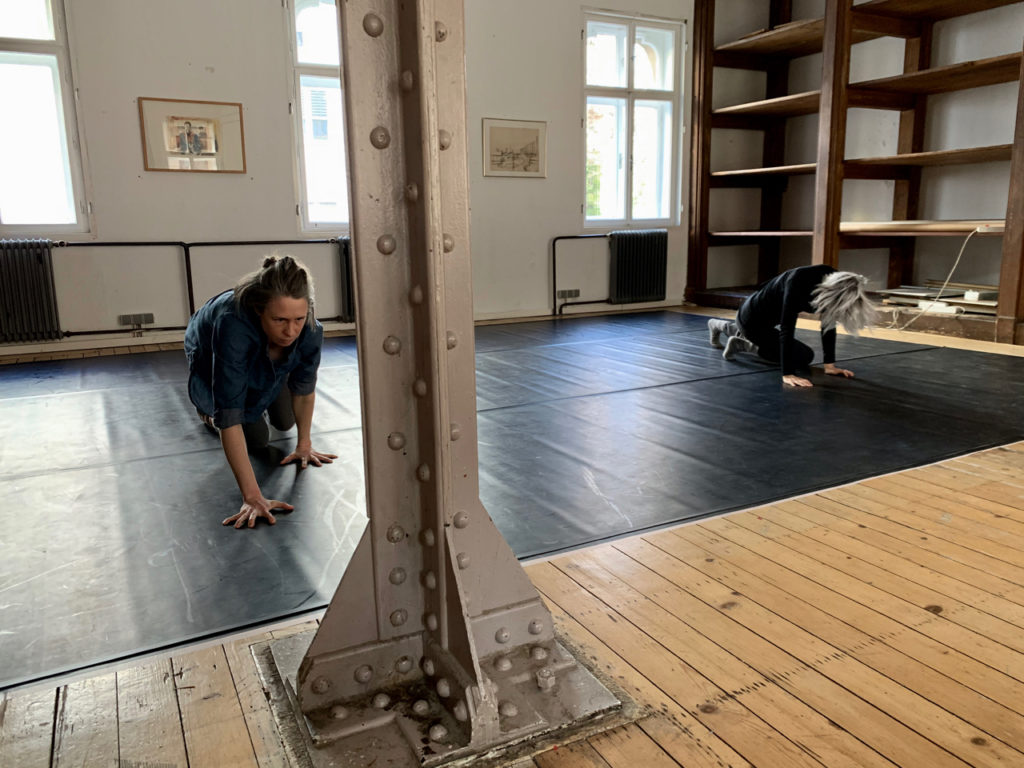
We began each day with a morning warm-up, then continued to study Bianchi’s ELP-method of aural transmission of choreographies. Juliet Fraser and I explored with vocal material I had prepared, including improvised textures. Then, we experimented with combinations of certain movement material and vocality in space. While Paola and Juliet worked on the rehearsal stage, I watched, listened, filmed, took notes, with my sense perceptions opening up during the process of closely observing. Conversations and feedback session followed. The intensity of witnessing triggered thoughts and ideas, I began to compose on the spot while watching.
Discussions brought us to look into aspects of timing: the old question of what comes first, the composition or choreography? In our case, it seems that Paola Bianchi and I had worked simultaneously on independent parts. Yet, in my process of writing the material for the research session, I had been aware of Bianchi’s ideas and concepts, because I am familiar with her work. I had her choreographies and her moving body in mind. Thus, my composition is linked with Bianchi’s ideas, it is not completely separate or independent. During the performance the process can turn around, with Paola Bianchi listening while Juliet Fraser sings. Then, the music influences the dancer’s movement, and her choreography is being adapted to the timbre and pacing of the sound.
At the end of the week, I felt grateful and satisfied about our artistic research – like after a good, nourishing meal for body and mind with friends. It’s fantastic to have the possibility to do this together and to share a work period of concentrated explorations with others.

16/02/20
Writing
Drowning
In orange
Smoke on skin
Ash between fingers
Between teeth
Grinding
Particles so tiny they invade me
Entering through my pores
Pollute
Lips, mouth, lungs
My voice my body brain
Be covered in orange dust!
Infested
Stored memories
Of unsung words
That no one hears any more
As I stumble between black tree stumps
Wanting to find home
20/01/2020
Representing. Exposing.

The exchange with fellow artists is food for my heart. Whether by mail, over Skype or phone, whether in person, meeting in a cafe, going for a hike together, at a performance, or in between two bus stops – it does not matter how, where, and how long. In-depth exchange can manifest over distance as well as across time, across centuries, with artists who are long dead but whose life and ideas continue to inspire my own practice. Recently, I came across a work of the Baroque painter Artemisia Gentileschi, in Vienna’s KHM Kunsthistorisches Museum. Visiting the building in itself is like travelling in time, into imperial and representational architecture of the 19th century. I went to see the exhibition Early Baroque in Rome centring on the works of Caravaggio and Bernini.

Emotions were depicted everywhere. Brilliant artworks showed figures in various states of rapture, often Catholic saints, Greek gods or goddesses, or otherwise mythical representations. One of the paintings on display, showing a woman reclining in a relaxed pose, her head slightly turned upwards with eyes closed, struck me as exceptional. In this image, rapture becomes a personal state rooted in ordinary life, rather than religious ecstasy, more a worldly state of body and mind emerging from within one’s own being, as one might experience when basking in the first warm sunlight of the day or relaxing after an excellent cup of coffee (or something similarly blissful). My impression was that the portrait of the woman was painted in order to expose, but not represent, an emotional state of composure and gratifying rest. It seemed to be painted as the statement of a strong individual, a human being, at home in her surroundings. The unique painting was by Artemisia Gentileschi – it was the only one in the entire exhibition painted by a female artist.

Why does this not surprise me? In 2019, I made interesting, and somewhat similar, observations at the exhibition City of Women, which showed unknown works of female painters in Vienna from 1900-1930. Here, too, the excellent artworks appeared to expose rather than represent. I find it difficult to verbalise what I perceived there, without generalising and simplifying. There was an overall atmosphere that was strikingly different from the usual art exhibition displaying the works of male artists. A kind of well-handled emotionality? A kind of friendly familiarity with the hidden corners of human life? A kind of being-at-home in physicality, a kind of being-grounded-in one’s body, in addition to them being highly professional artists? There is a directness in exposing rather than interpreting – I like to use these terms here, borrowing from postdramatic theatre, because they can precisely describe what I observed.
15/12/2019
MATTETOLINE
All photos by Barbara Pálffy @White Box, off-Theater


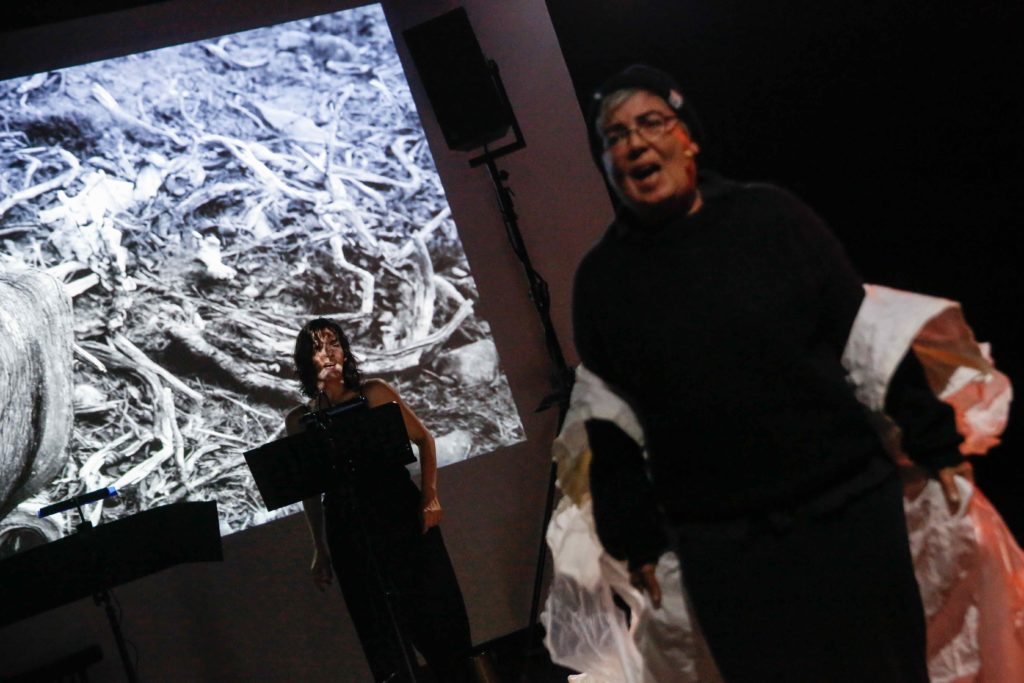


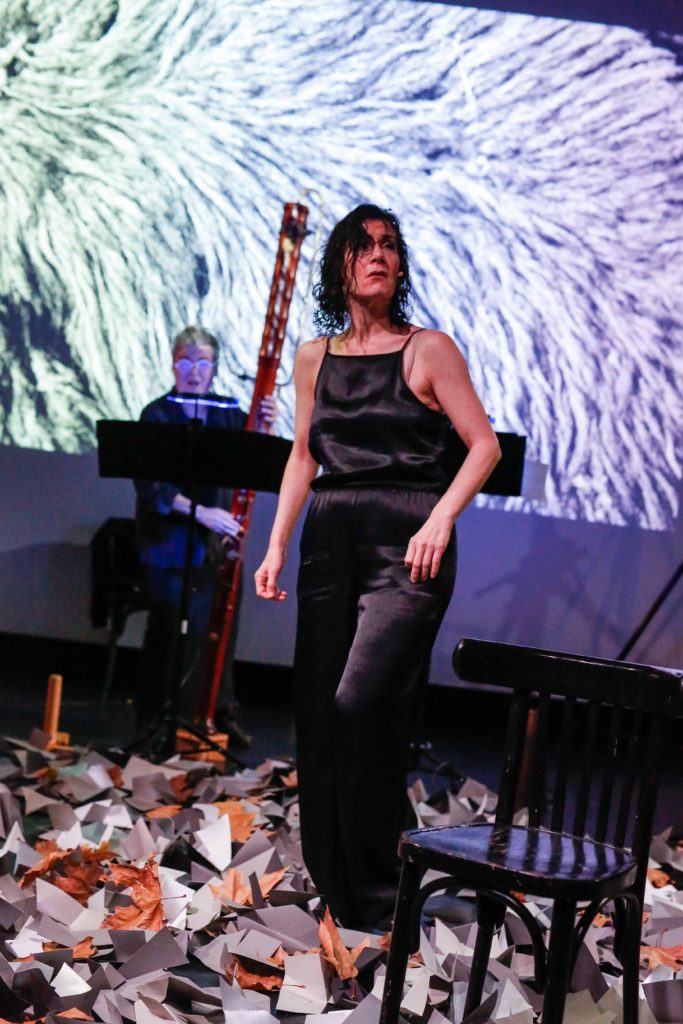

26/11/2019
Cutting and folding:
experimentation with paper.
In a studio space, in Vienna, preparations for MATTETOLINE continue. Experimenting with paper, I make installation objects. The theatre stage would be covered with black dance floor matting. As flexible visual and sonic element, I had planned to spread out natural leaves on the flooring. Large leaves, gathered from platana trees nearby, were laid out to dry in my studio.
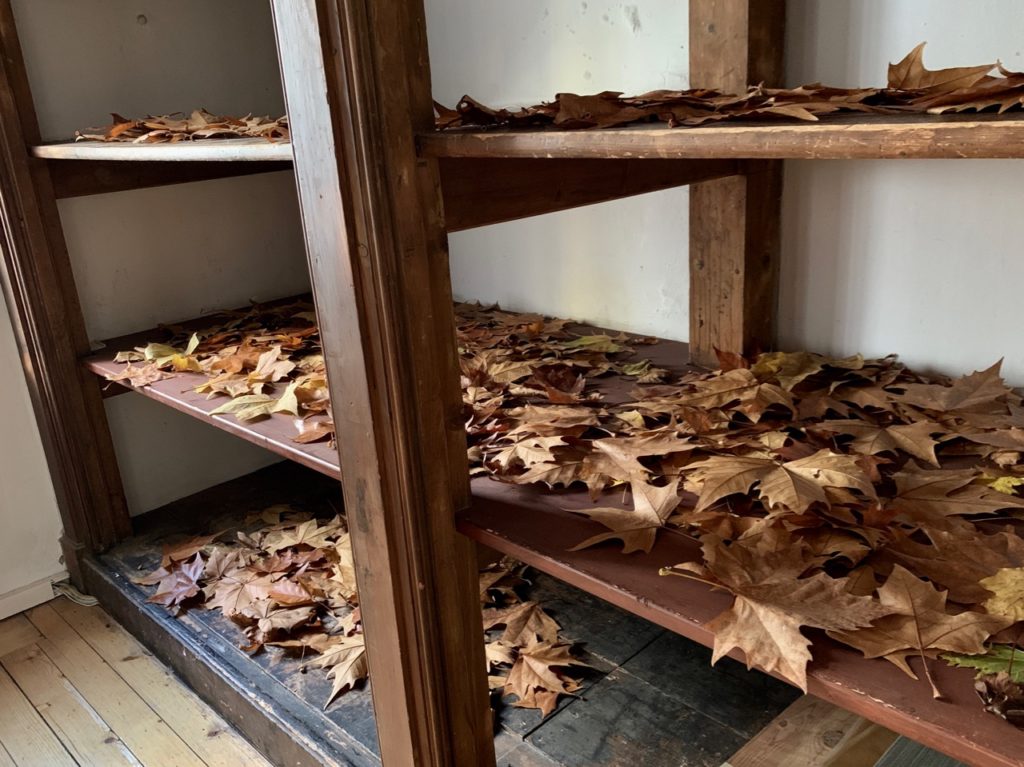




Because of the official safety regulations in theatres, however, we were advised to use only a small amount of natural plant material. Therefore, my idea was to make simple geometric objects of thick paper instead. Spontaneously experimenting, I cut and sliced pieces of paper, slightly varying shapes and sizes. With origami-style folding techniques, irregular three-dimensional shapes were formed. A successful free-style practice was developed, and, with helping hands, a large amount of those paper-objects was produced. Finally, all natural leaves and paper objects had to be thoroughly impregnated, for fire-proofing.
geometric & natural leaves
16/11/2019
To my beloved practice

Orpheus Summit 2019 in Ghent
Vida L. Midgelow, artist-scholar in the field of dance and choreography, presented the final session. At one time, during her brilliant exploration, she proposed an experiment: we were asked to imagine artistic practice as lover or close friend. From this perspective, what would we want to express? The exercise was to write a love-letter to one’s practice. The experiment immediately triggered a response in me, the following text flashed into my mind and was notated in one flow, without hesitation. Thanks to Vida Midgelow for her inspiring talk, and for doing this exercise with us (I’m determined to do it over and over again).
Dear practice
You are my heartbeat
Heart beating like a big drum
Repercussions shaking my mind my body
My pen as I write
The distant river trembles
Resonates
Heartwaves rippling
Across the ocean
Touch the big whale’s skin
Making her slightly shiver
With a strange kiss
From dry lips
As for the symposium, I found it intense and rewarding. Spending time with a community of equal minded artist-researchers from all over the world made me feel at home and stimulated my practice. Time is needed to digest; I will write more later on.
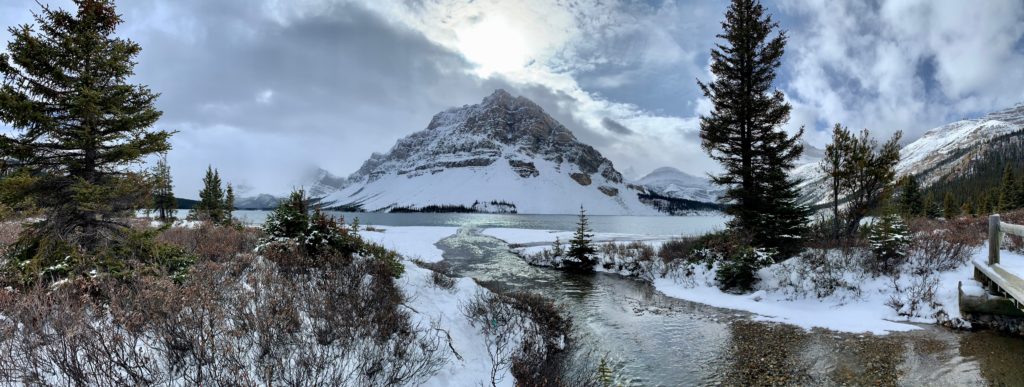
20/10/2019
Eiswelten
Ein verhangener Tag. Ich bin mit einem Mietauto – so richtig touristisch – unterwegs am Parkway zwischen Banff und Jasper. Beim Bow Lake halte ich an und gehe den Wanderweg entlang des Sees in Richtung Berge. Die Landschaft wirkt unwirtlich, unbarmherzig und zugleich großartig. Eine Landschaft, die mich nicht braucht. Ich komme mir verletzbar und klein vor in der winterlichen Weite, gleichzeitig sehr lebendig. Der See schimmert grau, weiter weg schwarz-weiß Kontraste: Fels und Schnee. Hellgrau der Himmel, eine Ahnung von der Position der Wintersonne hinter Wolken. Kaum Menschen unterwegs, es ist kalt. Pulvriger Schnee macht das Gehen leicht.
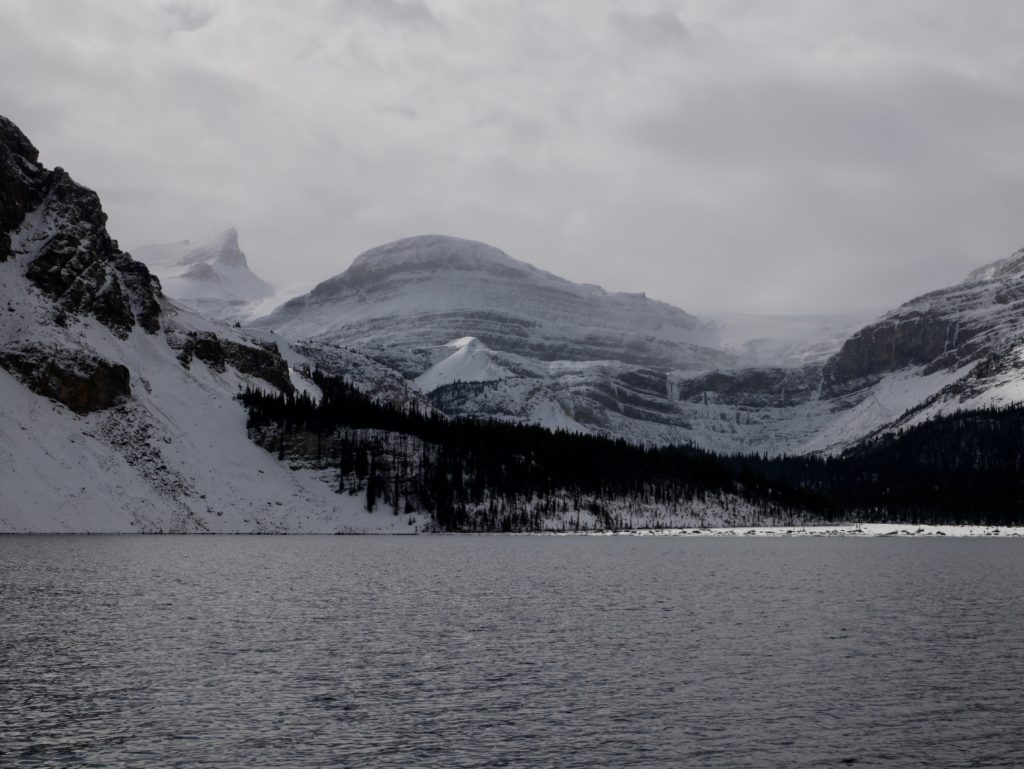
Am Seeufer bemerke ich zwei Frauen, die ruhig am Kieselstrand sitzen, die Rucksäcke abgelegt, trotz der eisigen Temperaturen. Fischen sie, machen sie ein Picknick? Beim Näherkommen sehe ich, dass sie konzentriert dabei sind, zu fotografieren. Sie vertiefen sich in ein Detail am Strand. Ein Bach mündet hier in den See, der Rand des Wassers über den Steinen ist vereist. Die beiden Frauen haben eine kleinräumige, ungewöhnlich Formation aus Eiskristallen entdeckt. Eine winzige Kostbarkeit für Augen und Ohren: es gluckst leise unter dem Eis, manchmal knackt es leise und hell.
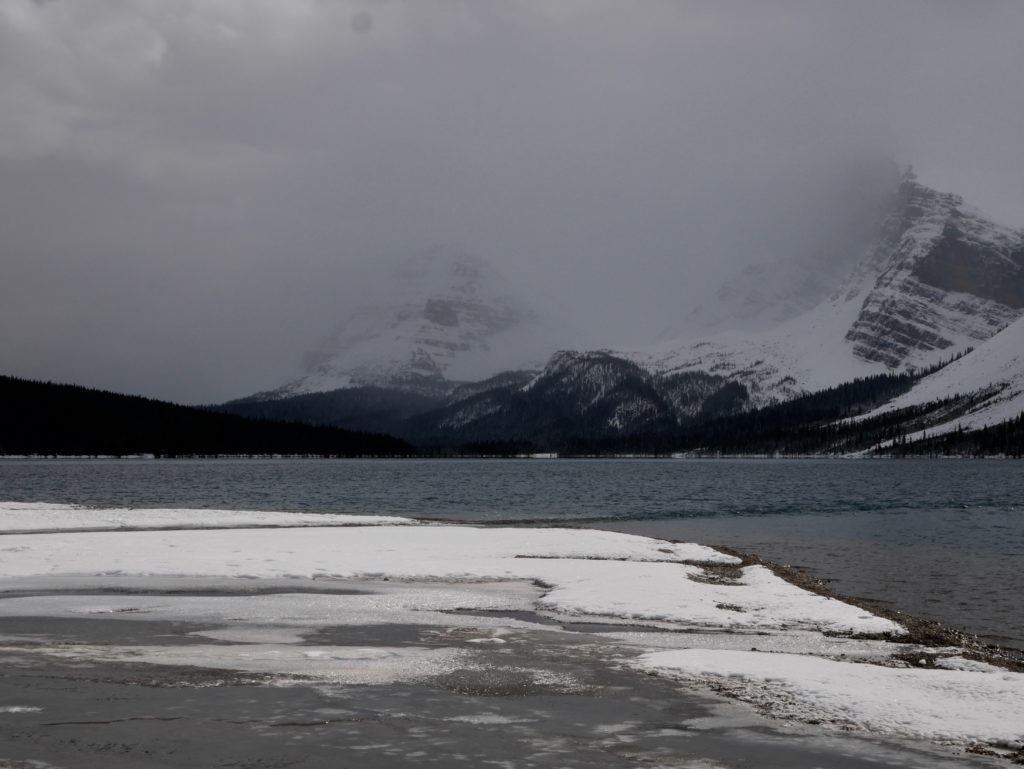

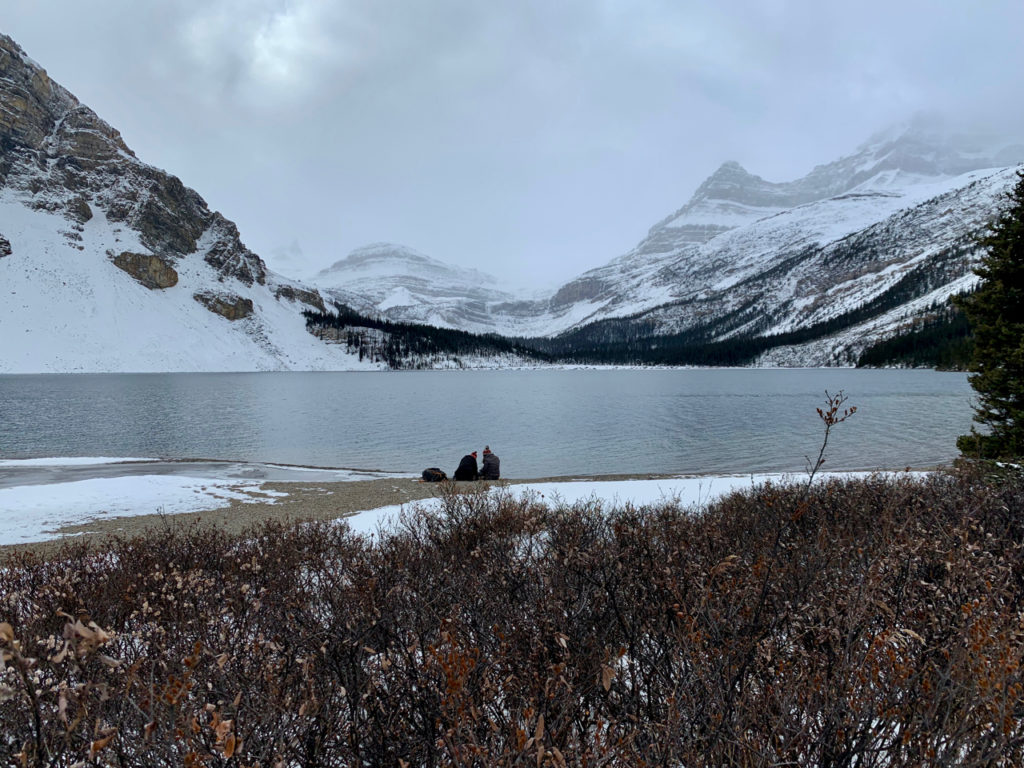

Inmitten der riesigen Gebirgslandschaft finden zwei Frauen ein feines Detail und versinken darin. Sie machen Bemerkungen über die Position der Kamera, die Einstellungen. Sie fachsimpeln. Dem Klang der Sprache nach sind es Amerikanerinnen. Ich möchte sie nicht stören, spreche sie kurz an und fotografiere anderswo. Als die beiden nach einer guten halben Stunde den Ort verlassen und weitergehen, filme ich die Eisformation. Ich freue mich über die beiden Entdeckerinnen und bin ihnen dankbar, dass sie dieses Objekt gefunden und mich darauf aufmerksam gemacht haben. Vor meinen Augen und meiner Kamera tut sich eine wundersame Welt aus Eisformationen auf, gefiedert, mannigfaltig und geschwungen. Pure Schönheit? Ich bin begeistert.

19/10/2019
Experimentation and sound material
Today, I document sound material that I gathered during the last weeks. My favourite sounds come from dry plant material. These materials were gathered within a few meters of my studio. After a few days at room temperature, they were completely dry, brittle, and crisp. After my experiments, I brought everything back to where I had originally gathered those plants; in a National Park like Banff it is forbidden to gather and remove any plant material whatsoever. I like the touch, sound, and looks of biologic material. It’s so simple, it’s just there, existing without any human intervention. I want to go back to the roots (radical?), eschewing the pressure of having to be innovative – what’s innovative, anyhow, in the period of the anthropocene? Everything is contaminated. Also, I like the idea that human beings may have played around with plants like that before, probably since the earliest days of humanity.
15/10/2019
Skinpaperfragility
A text for a piece, written in Banff
My skin has thinned so much
I can read my voice
My heartbeat
Melting
Dripping
As my fingers caress
Wounded sheets of grey ice
Frozen dreams
Worn down
Forgotten
Piled up in the riverbed
A mass of pebbles
Stones scattered
On hardened ground
All water gone
Bared of life
My skin rubbing against
Rocks so rough
Cracks
Cliffs
Crust
Bark
Chafing my flesh barely held together
My lips scraping across the mouthpiece
My skin has thinned so much
Is raw from having listened to unknown
Sounds
Noises
Languages
Words
Music
Distant dialects
Forests and plants
Trains and messages on my phone
My skin getting thinner every night
When I lie down in that simple bed in my room
So basic and historic and yet
Such a necessity
To make music
In a studio of one’s own
That tenderly holds my body my mind my sounds my instrument
Giving birth
Blades of grass still upright as snow falls heavily
My skin has become
So thin that I see my heart beating
My heart wrapped in
Skin Paper Fragility
Dressed in marks
Wrinkles
Traces
Notate my thirst my pain my tears
My love my voice my belonging
30/09/2019
Nature, composition, and the void.
Recently, I have been noticing a quality of insistence and narrativity in my own compositional practice – something that is new to me. I feel compelled to cross over borders and disciplines. I want to use all kind of means, tools, materials, and instruments. Rather than experimenting out of curiosity or playfulness, as I did before in earlier stages of my career, I now feel driven by a certain hunger, craving, and need. Writing texts, I am aware of a sense of desperation. Wherever I move in the world when travelling as an artist, I experience a similar dark undertone, a background noise. The same kind of situation follows me, or, more accurately, I carry the same kind of awareness to every space I interact with. My practice has become entirely situational, environmental – or rather, situations and environments have become fully personal. The world affects me, pollutes all the pores of my body. Purity can no longer be maintained, neither in composition nor in musicology, neither in performance nor in theatre studies.
In the anthropocene, I drown and surface.
In the anthropocene, all borders dissolve into each other. Microplastics are omnipresent and penetrate everything. Mankind and nature can no longer be separated. The dualism of nature/culture can no longer be supported. Emotion and reason can no longer be separated. Art, research, and science can no longer be kept apart. Dualistic concepts of gender can no longer be upheld. It appears that dualisms are currently under siege from all sides: the anthropocene and feminism work together to break down patterns of thought, habits, social roles, and hierarchies. This can be a clear sign of structures breaking down on a larger scale. Could it be that the urgency I feel in my working process is fuelled by this breakdown?
The French philosopher and anthropologist Bruno Latour (Davis and Turpin, 2015, p. 44) notes that the interdisciplinary exchange across science and art has become much more urgent today. He states that ‘because of the very logic of the anthropocene, you are inserted into the phenomena you study in a way that is unexpected and still unfathomed.’ Latour (Davis and Turpin, 2015, p. 47) recognises a ‘narrativity, and an urgency also, shared by people who are completely different in their approach.’
In collaborative work across disciplines, artists and scientists contaminate each other’s practices. We desecrate each other’s territories. During an ongoing discourse over the last years, we have been sharing our explorations in the fields of composition, performance, artistic research, and theatre studies. The interdisciplinary exchange has entered a state of being-with and being-involved.
Currently, I am in residency at the Banff Centre of the Arts in Canada. Watching my steps during a hike in the National Park, I scan the forest floor. Even high up in the mountains, human garbage is a reoccurring sight: plastic bottles, cups, cans, wrappings, tissue, bits of manmade materials. On the other hand, here in the city, animals roam wild. Deer graze in village gardens and flower beds, stags carry out their mating season fights right in people’s backyards (for example, watch the video at https://www.theweathernetwork.com/ca/videos/gallery/bc-residents-get-frontrow-seat-to-mating-season-dispute-in-their-backyard/sharevideo/6089435165001). A herd of Wapiti graze on the well-kept lawn of the Banff Centre Campus and ravage the flower arrangements decorating the restaurant terrace. Have they become accustomed to the taste of the soft, artificially-fertilised grass? Rabbits and squirrels scurry along, while various species of birds feast on whatever garbage human beings have left on their paths.
At the beginning of the process of working on a new performance or composition, I often experience a sense of emptiness. My state of mind is blank, as if I were in a void. One way of looking at that experience is from the position of feminist practice. In this context, I refer to the philosopher and art historian Cornelia Klinger. In her critical study of the conceptualisation of dualisms, she looks into their structures and functions. Her conclusion is that the formation of dualisms helps to uphold rigid patterns of thought and systems of knowledge. Thus, they serve to support social hierarchies and work against feminist practices (Klinger, 2019, p.173). She boldly states that dualisms are simply not necessary, as they are false. As an alternative, she suggests acknowledging the plurality of the other. It is necessary, she concludes (Klinger, 2019, p.174), to shed all formerly accumulated systems of knowledge and take the step to into ‘nothingness’ [“Schritt ins ‘Nichts’ ”]. As both an artist and as a feminist, my practice continuously propels me forward into empty spaces. In the process of composing, I drown in the void, and surface again.
Being outside, in a natural environment, helps me to move forward into the realm of nothingness. For a woman and artist, nature can be a terrain empty of social roles and hierarchies. In that sense, nature offers freedom and relief. In the forest, neither gender assumptions nor artistic expectations exist for me. Am I trapped in some kind of neo-romanticism here? No, it is different: nature simultaneously provides a home base and a projection space. I am part of nature and nature is part of me. My process of perception is nature looking at nature, nature listening into nature. I experience nature as my own heart and body of wilderness, as my own inside and outside, as the mycelial power of the pre-human, the fragility of the trans-human, the uncontrollable force of the post-human. Nature is a constantly changing space, not a static space. Nature is performative space, not a collection of data.
This passage taken from Margaret Atwood’s book Surfacing (Atwood, 1977) articulates my position:
I lean against a tree, I am a tree leaning
I break out again into the bright sun and crumple, head against the ground
I am not an animal or a tree, I am a thing in which the trees and animals move and grow,
I am a place
I have to get up, I get up.
Through the ground, break surface,
I’m standing now;
separate again.
With Atwood, I experience myself as part of nature and at the same time being able to step outside of nature. In her introduction to Atwood’s book, the writer and literary critic Francine du Plessix Gray discusses ‘female naturalism’. She argues that Atwood’s writings surpass “dangerous stereotypes that assign ‘earthiness’ and ‘instinctualism’ to females” and bring about empowerment instead. Gray draws our attention to the unique persistence of the heroine’s quest as an innovative aspect, which is central in Atwood’s book. In a radical turn, the female figure becomes a visionary protector – because she deeply and relentlessly searches for her vision, embracing solitude as well as testing the extreme limits of humanity. Atwood’s heroine recognises the performative dimension of nature, immersing herself in its dynamism with the ability to step out again at will. Atwood’s approach to nature differs from the more civilised and controlled approach presented Thoreau’s Walden Pond. Atwood talks about her own movements as part of nature as she describes her body motions and her thinking process. Her lines notate a personal and intimate situational performance.
As Atwood, I also understand the conception of a ‘heroine’ as different from classical mythology or romantic art. In Atwood’s figure, I appreciate the notion of an intense and relentless search for a vision. The kind of urgency that Atwood’s heroine feels corresponds to the urgency I currently feel in my compositional process.
Bibliography
Atwood, M. (1979). Surfacing. London: Virago Press.
Davies, H., and Turpin, E., eds. (2015). Art in the Anthropocene. London: Open Humanities Press.
Klinger, C. (2019). Dualismenbildungen: dem Denken vorfindlich, unausweichlich und falsch. In Handbuch Interdisziplinäre Geschlechterforschung. Kortendiek, B., Riegraf, B. and K. Sabisch, eds. (2019), pp. 165-175. Wiesbaden: Springer. Available at https://doi.org/10.1007/978-3-658-12496-0
27/09/2019
A performance with a bass drum and a sheet of paper
A big sheet of heavy drawing paper corrupts the sound of a vibrating bass drum. The paper is suspended from a cymbal stand and touches the surface of the drum. To begin the performance, I lift the paper with one hand, so that the drum can vibrate without disturbance. Specific forms of vibrations are created by friction and movement with a superball on the skin of the drum. Minimal changes of pressure, movement, and the area on the drum influence sound production. As soon as the paper is lowered onto the skin, its vibrations are disturbed by the paper. On the other hand, the paper begins to dance along with the vibrations of the drum. It jumps up and down, producing an irregular tremolo effect. Later in the performance, I crush simple plant material (leaves, cones) between my fingers, gently touching the material to the skin of the drum for amplification. Finally, I write with a pen on a piece paper laid on the drum’s surface, murmuring the words while I write.

25/09/2019
More Radically
This text manifested during the first days of my residency at Banff. I took long walks in the vicinity of the Banff Centre, at times idly and aimlessly wandering around, then again with more determination. I took in the environment, sights, smells, sounds and noises. The air, the rocks, the water, the forest, meadows, animals. The city, the tourists. The trains. I felt welcomed and held by the landscape, felt at home. I perceived a strong presence around my body, and wrote this text about my explorations. I used the text for a work that was performed at Banff Centre at Rolston Hall, with one of the residents, the wonderful British mezzo soprano Rosie Middleton.
More Radically
She summons
Spirit voices
She summons
Spirit voices
She summons
Spirit voices
I summon you
Crawl into my ears
I may not speak your language
But I hear your noise
Beneath the surface of the visible
As I listen
My ears
Underneath the skin of the land
Underneath my own skin
Can you hear me, too?
I’m not a nati-[vvvvvv]-e of this land yet feel at home here.
Do we have a choice?
Come here
Mistresses of the forest!
From the mountain tops
From the riverbeds
From the depths of cold lakes
From the rocks
From the cracks and crevices
From the bogs and marshes and hot springs
From the trees and from the earth beneath their roots
From the bridges
From the roads
From the rotting carcasses of countless salmon
Fertilising abundant growth
From the clouds and the morning mist
From the trains and cars
From the souvenir shops, too
Come, sly deceivers of innocent tourists!
Do not corrupt our minds with cheap delusions,
listen to me and come here!
She summons you into her music
She summons you into her noise
She summons you into her mind
She summons you into her body
Come here
Come here
Come here
And join her
Ride her breath
In a frenzy of sound and noise
Dance in and out these openings
Dance on these keys
Dance with these fingers
Dance on her tongue
Dance in hidden formations inside this hollow pole
Dance in her mind
Dance in her heart
Dance in her voice
Assemble
Settle down within this piece of wood
Be as wild as you want
Be as gentle as you want
Roam this playground of
Wood
Metal
Lips
Fingers
Flesh
Blood
Pain
Bones
Teeth
Sinews
Nails
Brain
Thoughts
Passion
Heat
Longing
Take me with you
Spirits of noise
To celebrate
More radically
From now on
22/09/2019
Nature & people.
Performing Mirror Lake.



Hiking Lake Louise with fellow artists, I observe – or rather: participate in – the striking relationship between superb ‘natural’ scenery and a huge number of tourists. Dozens of people from all over the world stop at the very same spots to take pictures. One never walks alone. Every one of us tries to catch nature in its purest form, without, or with only a few curated people appearing in the foreground. The above photos were all taken with great care and much patience, so that nature could take the stage completely. Behind me, and to the sides, dozens of hikers were halting, too.
On our way up to the fabulous, cozy teahouse at Lake Agnes, we pass Mirror Lake. Such a small, clear body of water; its fragile shoreline is severely eroded by the steps of the many hikers stopping here. People try to get as close as possible for a good shot. This pano-shot shows both ends of the view: stage and audience, or the autoethnographic view.

15/09/2019
Model and reality
To orient myself, I walk into town and around. The iconic Fairmont Banff Springs as model at the airport hall, and in reality, above Bow River Falls.
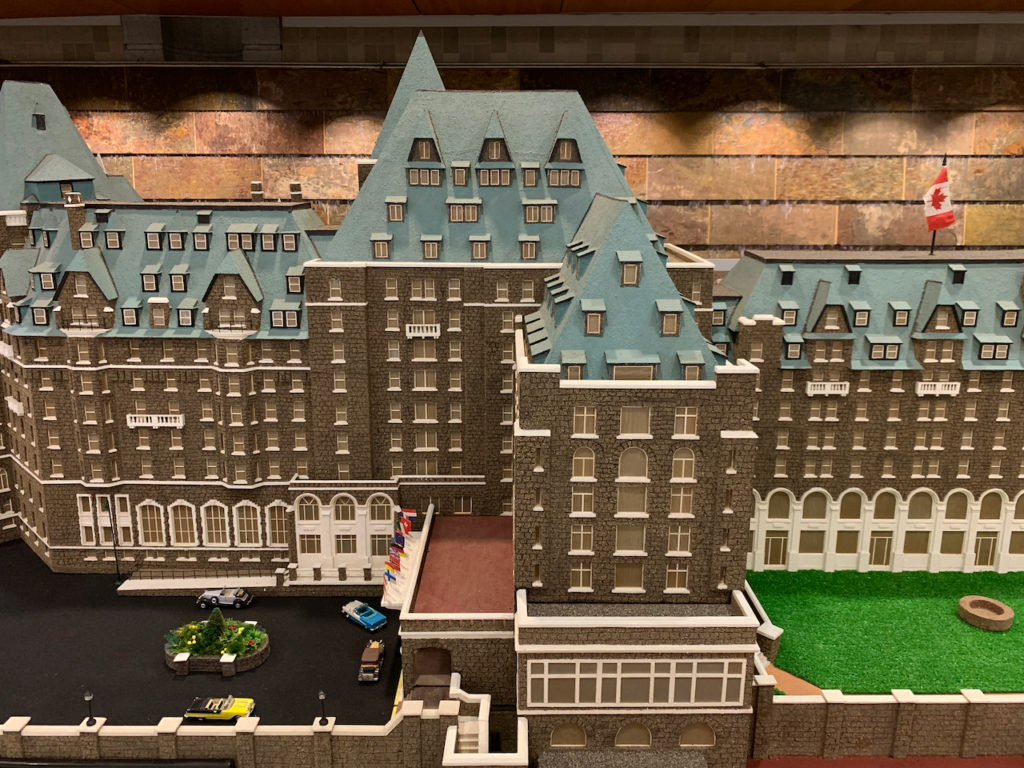




Sept.-Oct./2019
The Banff Residency
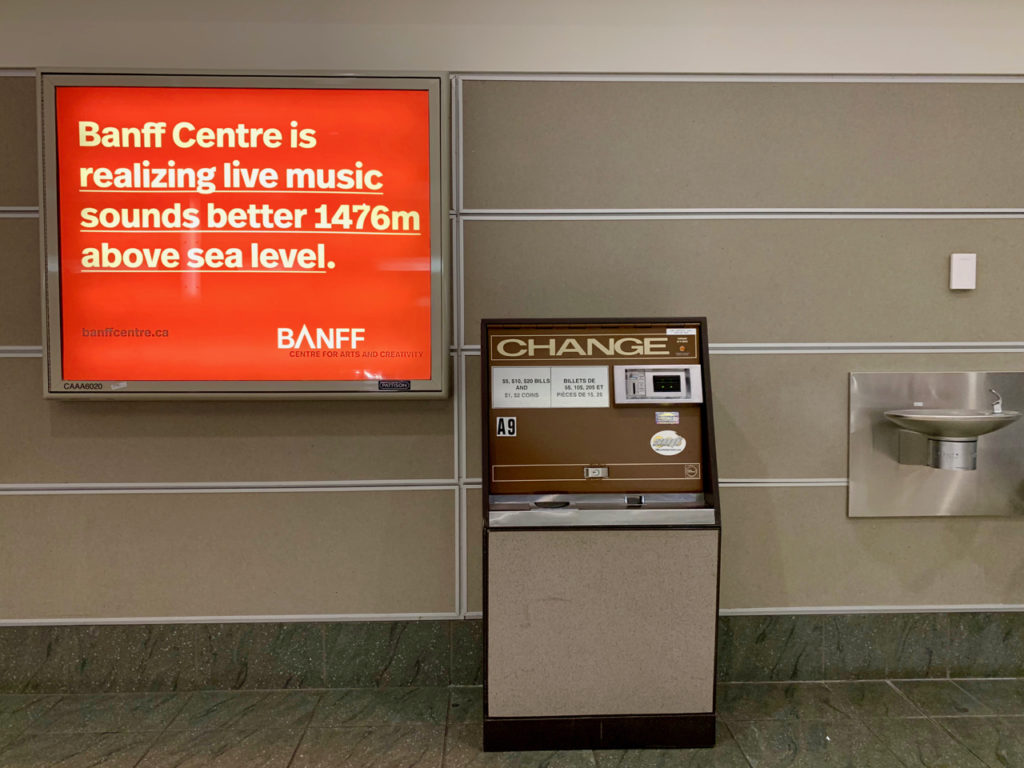
From September 15th October 19th 2019, I participate in the Banff Residency Programme for performing arts in early fall. As part of a group of musicians and composers, I work and live at the Banff Centre of the Arts in Alberta, Canada. This is my studio: upon entering this room, Virginia Woolf’s quote ‘A Room of One’s Own’ immediately came to my mind. Never before did I have a studio space as big just for myself. Also, I have a bass drum to work with.

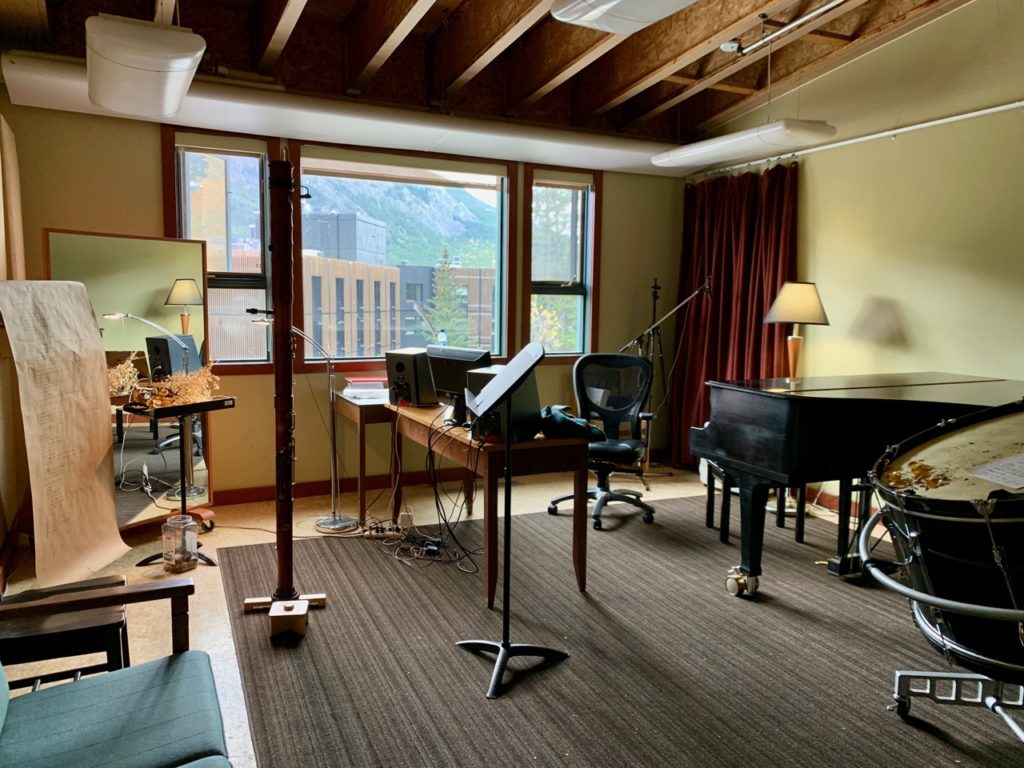
For my next scenic production, I conduct experiments with the bass drum, with plant material, and paper. From the first days on, texts and ideas manifested, inspired by the land and environment.
25/08/2019
Recording rivers

In my recent blog entry, I wrote about Time and the stream of time that I experience in my life. Lately, I have turned to more material rivers and streams. Using a hydrophone, I have been recording sounds of rivers under water as part of my composition research. The nature/culture dyad is currently in my focus. For me, culture includes technology. A few kilometres upstream from Vienna, the Danube is a fast flowing, cold and majestic river. A nice public beach is located here, the historic Strombad Kritzendorf. The disastrous flood of 2008 deposited a lot of sand right on river bank. Huge old trees stand on the sides, providing shelter and shade. A wide meadow slopes down towards the river and allows easy access to the water, also for swimming. The trick is to walk upstream, then swim down again, carried by the powerful current. In this place, it is almost impossible to swim against the river’s flow.
Throughout the late afternoon, I hear a lot of noises. A number of small boats as well as big ships cruise up and down the river. Airplanes fly low over the area, as they are approaching the airport down south of Vienna. The buzz and hum of machines is everywhere. When the boats have passed by, long waves break on the river bank. I stand up to my thighs in the water and balance the microphone under water, at times slightly above the river bottom. Sometimes I bring it close to the surface and hold it at the border between water and air. As I listen through headphones, the noise of distant boats appears as a penetrating, high-frequency sizzle. Is that the motor whirring, or pebbles moving in the river bed? The strong and steady current, in combination with occasional waves creates clicks and crackling noises.

I refer to the sound artist Annea Lockwood and her installation featuring recorded and composed material about the Danube, as part of Donaufestival Krems. Lockwood recorded the river along her (the Danube is female, for the people in Central Europe) entire stretch, from the source to the delta. The artists states that (from: Lane, C., and A. Carlyle, In the Field. The Art of Field Recording. Uniformbooks, Cornwall 2013)
“…the cultural differences in the environments feed into the whole ambience, and also one spot on the Danube sounds different from another spot – the gradient, the composition of the banks and riverbed, how much energy and friction there is, whether it’s cold – all these parameters affect the sound and make it impossible for any one river to have an intrinsic characteristic sound.”
On the shore, I find a pair of tiny bells and play around with them. Their soft tinkling contrasts the hum of the motorboats; I record a video with my iphone.
Quite different from the Danube, the Schwarza is a small mountain stream running through the Höllental (Hell’s Valley) near Reichenau. Even during periods of hot weather the valley bottom stays cool and shady. The river landscape offers beautiful spots, unexpected river bends and diverse rock shapes, pools and small gravel beaches. The water of the Schwarza has a pristine turquoise hue; it is clear and very cold. At times, when the sun shines down onto the valley bottom and the temperature changes, a blueish mist arises from the surface, quickly and seemingly out of nowhere, lingering above the water for a while.
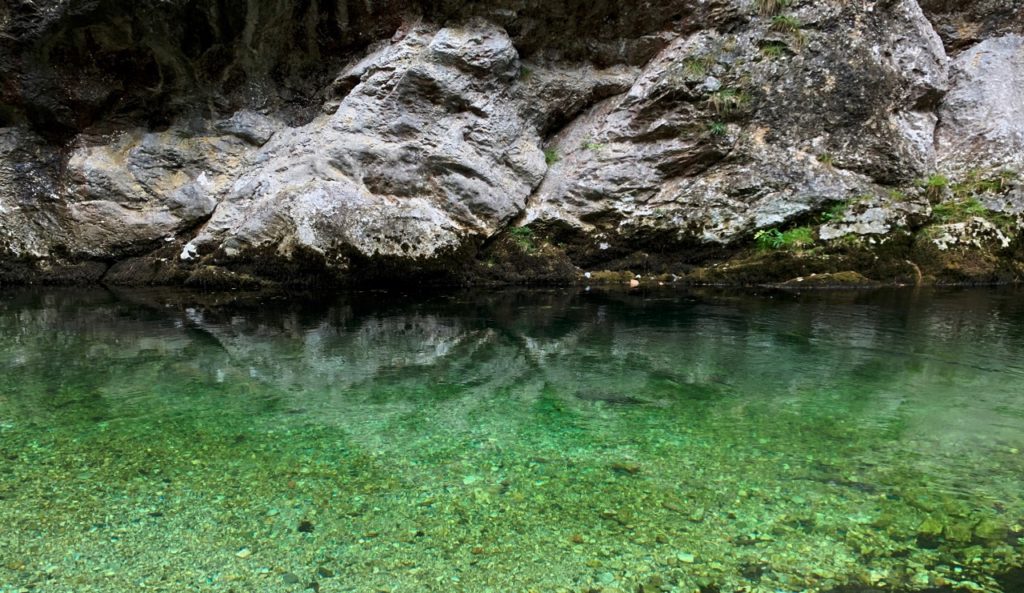
On a clouded day, I travel to Höllental and unload my gear on a small patch of gravel next to a gorgeous, deep pool of the Schwarza. This particular spot is one of my favourite places. The water is currently low because of the dry summer. For a long time I stand immersed in the river and direct the microphone, in order to record various sounds of flowing and swirling movements in different spots. I move the microphone in various directions, at times deeper down in the water or higher up at the surface. The water dances around the mic and around my legs. Stepping out of the water, I notice that my legs and hands are swollen red from the cold. My hearing perception is changing. After the recording session I take a short swim in the Schwarza pool. A challenge, and I love it. Clarity and biting coldness. Cryotherapy?


Finally, I collect pieces of garbage left by visitors on the river bench. I have made it a habit to gather and remove garbage in locations where I have stayed, both in natural surroundings and the city. By so doing, I feel I can give something back to the very place that has hosted me in turn. The valley is a natural reserve; it used to be quiet, lonely place. Over-tourism can now become a problem. With the heat increasing during the summer months, the river has become an increasingly attractive refuge for city-dwellers. On summer weekends, people flock to the river banks, crowding small spots that are easily accessible, often without awareness about the fragility of the environment they have entered.

19/08/2019
Die Zeit
Ist die Zeit
Ein breiter Sog aus Farben
Dahin geströmt
Im dunklen Kleid der Nacht
Kraftvoll vorbei
Gerauscht
Geflossen
Gezogen
Getanzt
Gesungen
Gekreist
Geworden
Gewandelt
Im Schlaf ist sie Tag
In lichten Tönen
Bunt wie ein Regenbogen
Schillert
Flirrt
Verlockt
Verführt
Große Zauberin
Hast die Tore zum Käfig weit geöffnet
Sobald ich inne halte
Bin ich verloren im Augenblick
Eingegraben zwischen Gegensätzen
Hier oder dort
Hier oder dort
Hier oder dort
Entweder oder
Sein oder nicht
Mann oder Frau
Oder doch nicht?
Du oder ich oder wir
Zeit
Unstete Wegbegleiterin
Einmal schwarz
Dann wieder leuchtend hell
Ein Schatten
Unseres Selbst
Eingebildet
Fiktion
Irrbild oder Wissenschaft
Schillert
Flirrt
Verlockt
Verführt
Wenn ich singe
Gibt es keine Nacht
Keinen Tag
Keinen Mittag
Keine Mitternacht
Keinen Mann
Keine Frau
Kein Leben
Keinen Tod
Kein Hin und Her
Kein Aus und Ein
Keine Natur und keine Wissenschaft
Kein Schlaf oder Wachen
Keine Stille und keinen Lärm
Keine Sonne und keinen Mond
Kein Du
Kein Ich
Kein Gegensatz, vor allem
Niemals ein Gegenpol
Wozu denn
Dualismus ist Konstrukt
Die Zeit sagt:
Höre in meine Tiefe
Die Natur sagt:
Höre in meine Eingeweide
Höre mein Blut rauschen
Höre meine Zähne knirschen
Höre meine Wurzeln wachsen
Ich schlage meine Wurzeln in dein Herz
Pulsierend bist du mein
Auf keinen Fall gehorcht die Zeit dem Irrtum der Bilder
Sind alles flimmernde Gestalten
Trügerische Oberflächen
In der Hütte der Furchtsamen
Kauern sie winselnd
An Gegensätzen festgeklammert.
Scheinbare Sicherheit des Einmaligen?
Umsonst
Am Ende alles eins geworden im dunkelbunten Strom
[Pia Palme, written in August 2019]
15/08/2019
Writing heat, politically thinking
Another heat wave. Why am I writing about the weather in a blog about artistic research? Because it is a political activity connecting to my practice. It has become clear to me that I must notate weather conditions and voice my immediate bodily perceptions here. I am searching for words to describe the transformation that happens in my environment. I search for a future, but the first step I must take is to become articulate.
As reference, see the groundbreaking Finnish artist and researcher Henna Laininen. She currently works on her project Climate change in me andconducts workshops to develop creative writing tools for communities, in order to empower people to deal with eco-anxiety [see her website http://hennalaininen.net/?page_id=359]. When I was a girl, people usually chatted about the weather when meeting on the street, in the tramway, in a park or a shop. Once, weather-chatting was a friendly ritual performed upon opening a casual conversation or exchange. Now, observing and writing about the weather and climate situation raises awareness. This, in turn, gives me freedom to conceive ideas and visions for the future. That’s what I am doing when I compose: I develop ideas for the future.
When it stays very hot for a number of days, I notice subtle changes in how I practice, think, or write. Patterns of disturbance are emerging. My thoughts fly outside into the heat, towards the trees in front of my window. Birds and insects have vanished; the skies are pervaded by a noxious silence. As change occurs, the link between my human body and my natural environment – the earth, plants, animals, climate conditions – comes increasingly to my awareness. If someone reads this blog twenty or forty years from now, they will see my artistic practice emerging alongside observations about weather, climate, and nature.
Upon a visit to the London Garden Museum [https://gardenmuseum.org.uk] last year, I was impressed by handwritten journals of professional gardeners from the 19th century. These gardeners had been gathering valuable data over the years, monitoring local weather conditions of a specific place linked with their practice. Precise documentation helped them to plan and oversee their future activities such as planting, cutting, pruning, or harvesting.

My own approach towards weather significantly changed in the summer of 1990 during a stay in the Rocky Mountains in Colorado. For three months I lived in a tent with my husband and our two small children. We were part of a larger group of people from all over the world who had gathered to study and practice Tibetan Buddhism at a local mountain Dharma centre. During that time, we were exposed to the entire range of weather phenomena that characteristically occurs in mountain areas. We came to accept the weather situation as a physical and mental experience, yet we continued in our daily routine, taking care of the children, studying, cooking, doing laundry, eating, and sleeping. Weather became a fact of life, rather than a theme of conversation. Heat was succeeded by cold, rain, hail, snow, fog, a thunderstorm was followed by a gentle breeze – I was fascinated by how quickly moments of brilliant beauty could punctuate longer sequences of discomfort. A sudden rainbow after a storm or a breathtaking cloud sculpture at sunset could immediately capture my attention, making me forget all our previous inconveniences.
These days I find my outlook on weather shifting, in parallel with an awareness of new weather patterns and political implications of climate transformations. In my mind-body, I have stored data about past weather situations; that is, I have stored mental and physical memories of my environment and myself as part of it. Growing older, my perceptional memory aids me in reflecting on my current experiences. I detect climate patterns because my perceptional process begins to stretch, time-wise, from the present into the past, and outwards towards a possible future.
I observe how trees in the city that I have known and admired since my childhood are struggling with the heat and drought. Many of them have obviously begun to suffer; some are prematurely shedding their parched leaves as they die. Sadness comes up. The woods near my home are drying out and the air smells differently than before, more reminiscent of a Southern European country.
27/07/2019
Rethinking musicology. Charting terra incognita.
Over the course of the past few weeks, I have encountered a number of remarkable women and participated in stimulating, sparkling discussions. Together with Christina Lessiak, I spent an evening at the home of musicologist Dr. Susanne Kogler in Graz. One of the topics that came up in our conversation was the idea of a new kind of musicology.
Extending from this discourse, I envision a musicology that would inquire into music, noise, and sound from a feminist position. In this way, musicology might develop into a practice that could in itself become performative and experimental. In contemporary music around the globe, the idea of ‘composing’ is rapidly evolving as it extends into experimentation, collaboration, sound art, performance, and includes various media.

Composition is now often a multidisciplinary practice involving various forms of improvisation and elements of visual art. A new type of composer/performer personality has emerged on stages worldwide. Mostly, they are women. Why? I think that women still have to find distinctive, unparalleled ways of pursuing their careers as composers or performers. At the beginning of their careers, women must often be more inventive and make do with less money and resources than their male colleagues. Looking for artistic niches to occupy, women* proceed creatively, often utilising electronic media and without having a large ensemble at their disposal. Women* often appear on stage themselves, performing their own works. As a result, their ideas open up new territories, regarding content and performative formats.

On a recent visit to Vienna’s Globe Museum, I took pictures of historic globes and the wonderfully crafted wooden floor. The museum is hosted in a baroque ‘Palais’ right at the centre of Vienna. Musicology as well as cartography are changing rapidly: contemporary discoveries disrupt old standards. Today, we move into new directions, we move away from an ideal of beauty that is grounded in a feudal system. I appreciate the craftsmanship on display in the museum and the building, but not the feudalistic conception of the world.

Looking at these moon globes in the museum, I recall that currently the 50th anniversary of the moon landing is being celebrated. Media features cover female mathematicians who worked behind the scenes, such as the scientist and software expert Margaret Hamilton. Why didn’t we hear more about them in 1969?
I have noticed that women* appear to compose and perform in unique and almost intimate ways – as examples, I refer to colleagues such as Maja Osojnik, Eva Reiter, Jennifer Walshe, Carol Robinson, Laura Bowler, and Mira Benjamin. Their works seem to draw on their private dimension, contributing emotional content without sacrificing their professional standards. Traditional analyses using the accepted values and metrics of the Western musical canon do not describe the novel and performative aspects of such artistic activity. Standard musicology seems to be too distant, narrow, and, in a rather traditional sense, quite ‘scientifically’ oriented. For me, science and art must move closer; they actually merge in my thinking. Theory must extend parallel to performance and composition, to include the object of research. Contextual and social aspects could be taken into account. Artistic research by musicians and composers must be taken into account. For this extension of performance, to include a theoretical and performative, modern ethnomusicology and autoethnography could provide a framework. Feminist composition and performance might be approached as a foreign territory, a white space in music.
Taking another position
for our research, within the framework of On the fragility of sounds Christina and I rely on ethnography and autoethnography as tools to describe and discuss new artistic works and processes. Interestingly, researchers from the fields of theatre and dramaturgy have become interested in contemporary musical performance practice. Researchers such as theatre expert Dr. Irene are exploring contemporary music performance from their theoretical position. With a fresh approach, they contribute new analyses and reflections that impact the physical dimension of performing, political elements, the body in space, aspects of gender, and the relation between the private and public dimension. All these aspects are part of musical performance on stage.
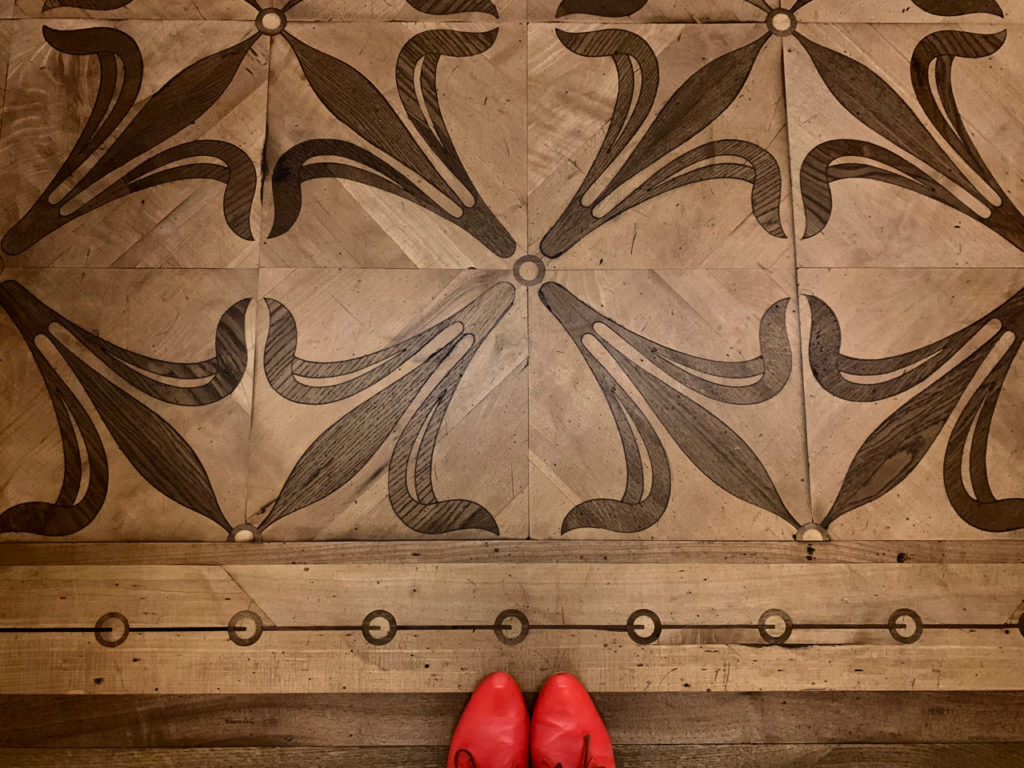
17/07/2019
On nature. Co-existing and surfacing.
These days, I reflect on nature and and write about it. I post pictures that show woods, landscapes, and trees right here in my blog and talk about rocks or water. I would like to define my conception of nature. Nature is important to me: I write texts that have been inspired by nature and use them in my music theatre pieces. Often I take videos and field recordings in – more or less – natural landscapes. Am I trapped in some kind of neo-romanticism?
In my practice, the dimension of nature is a space I belong to and can refer to. For one thing, I enjoy being outside in natural environments. Further, I look into biological processes, membranes, decay, transformation, and growth, into microbiology and cell systems. I live as a mortal being. My observations inspire patterns, themes, elements, or structures of my compositions and texts. Very recently, I became interested in rocks, stones, and earth as well.
Nature provides a homebase and projection space at the same time: I am part of nature and nature is part of me. The same could be said of culture: I am part of culture and culture is part of me. In the neuroscience discourse, the term ‘brainbody-in-culture’ has been established for this perceptional phenomenon (Schmitz & Höppner, 2014). My process of perception is like nature and culture together looking at nature and culture, nature and culture together listening into nature and culture. I experience nature as my own heart and body of wilderness, as my own inside and outside, as the mycelial power of the pre-human, the fragility of the trans-human, the uncontrollable force of the post-human. Co-existing with nature, all distinction between humanity and nature is blurred for me.
11/07/2019
On rock and timbral pigmentation
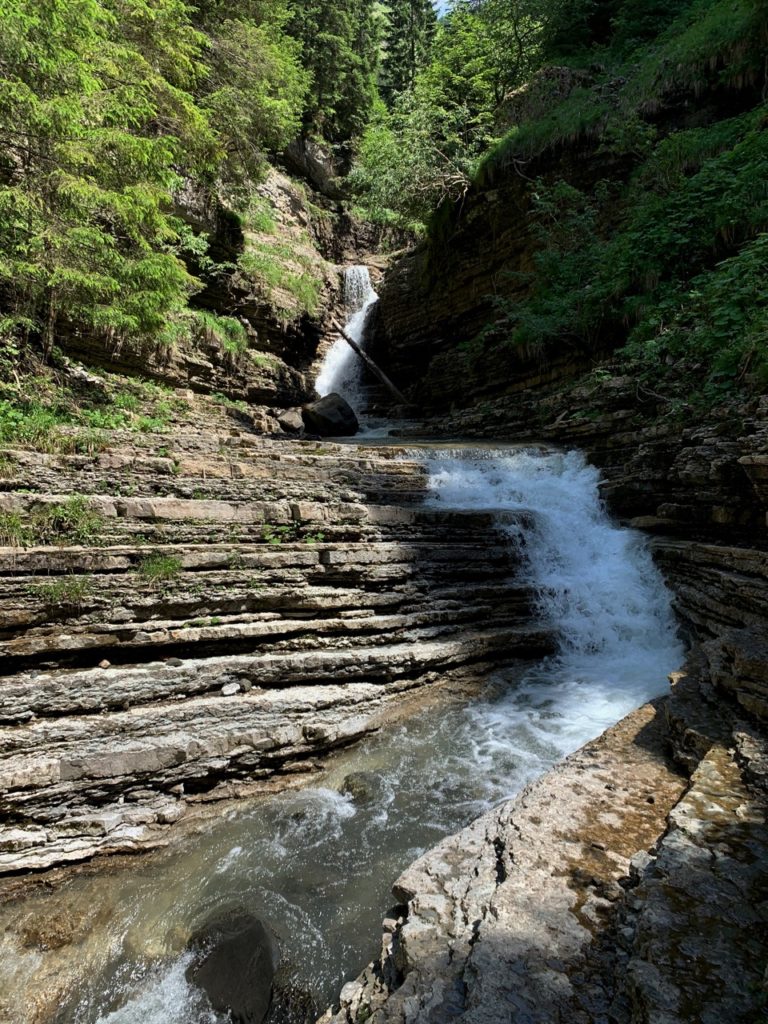


I am looking at rocks these days,
at different kinds of rocks
scattered on the narrow mountain path before me.
Boots meet rock
eyes look at rock
ears listen into rock.
Walking, shoes grind small rocks
they all sound different.
The brilliant colours of rocks
come to life under water
as I cross vivid brooks.
My fingertips touch rock formations to my side,
where grass and trees and thin layers of soil give way
to the bare underground
of rocks exposed.
Lovely bones of the planet!
Skeletons and bones have never failed to magnetise me. By collecting, exploring, touching, and handling bones, I draw out their structural similarities. Skeletal extract. As a child, I noticed that the skulls of various animals (including humans) display similar features. Since then, I wanted to identify underlying patterns of their build, in order to better understand how the skeletal framework supports living animals and humans.
Bodies
laid bare
telling of eras
beyond my imagination
How many generations of humans would it take to measure
the time that has passed since their forming?
How to measure the heat and pressure of their formation?
They appear to me
multi-coloured or single-coloured
as I cross strata from different geological periods
stepping on black pillow lava
greyish brown basalt in long strings
deformed
deformed
deformed
deformed
Conglomerates
or egg shaped
porous black
polygonal
deformed
columns transmuted side by side.
Discovering rocky patterns and formations gives me joy.
Gently cradling the black lava egg in my palm
I experience a time interval and distance in space
that I cannot measure.
Walking, I wonder:
am I approaching a border between biology and geology?
Where and how do biology and geology meet?
Is this the place where I will find myself after I die?
My body transforming to earth and stone in the borderland between biology and geology.
I begin to understand
how the colour of the ground
is their colour
as I walk on
ground
rocks.
Since reading Heidi Gustafson’s explorations on pigments gathered from ground rocks [https://thesideview.co/articles/dust-to-dust/] I have approached rocks and stones in a different way. In her article, Gustafson mentions that “when we die, our minerals are redistributed, largely as ashes or clumps of carbon, oxygen, calcium, phosphorus, nitrogen, and a handful of others elements.” I understand that she observes the quality of pigments by extending her perception beyond the visual. Just as I do with sound, Gustafson enters into stone and rock to touch them from within. Gustafson mines for pigments as I mine for timbral colours. Or rather, with Gustafson, timbral pigmentation. Pigments made from ground rocks extend the concept of colours, she writes, because pigments “intensify, confuse, and reorganise our felt sense of inner and outer, imagination and manifestation, self and nature, past, present, and future.”
I listen into rocks.
& feel their weight, their resistance as I trod on my path.
Their inner substance reveals itself to me.
Time is a barrier.
Their age. Their immense age. How to communicate across eons?
The piece of rock I hold it in my hand
against short-lived me
fragile me.
Does distance need translation, transformation?
I am collecting rocks for my artistic practice & want to use them for composing. Conceptually and physically. Rocks do not care at all. They have been compressed and twisted and transformed by powers far beyond mine.
The ephemeral human body & mind meet rock.
Sit down.
Timbral pigmentation.
Let me try to grind sound and noise.
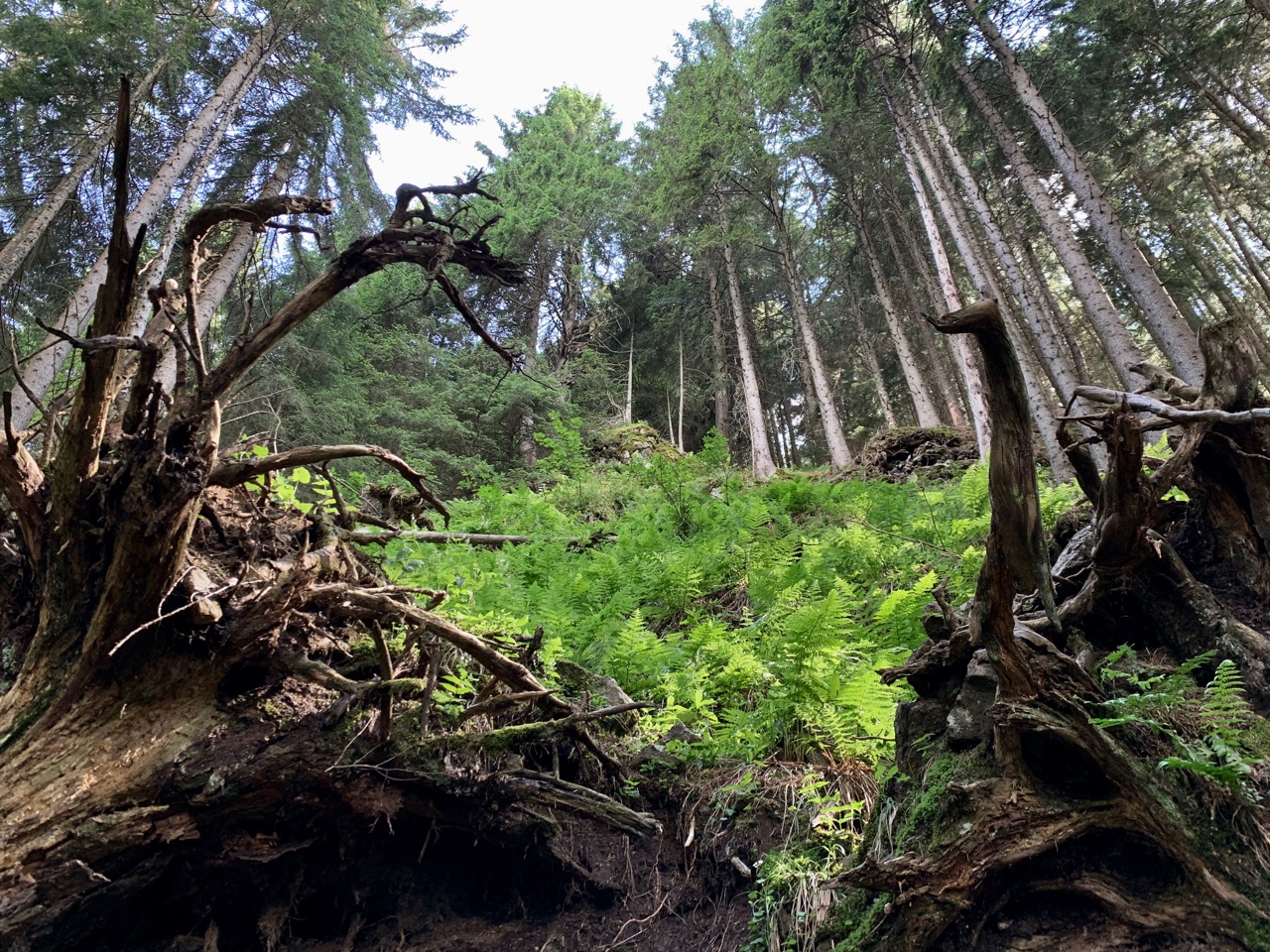
04/07/2019
Hiking delights
I follow an old, well kept mountain path in the shade, North sided in the dolomites, along steep slopes. I walk slowly. The water in this well tastes rich in minerals. I forget about art and composing and research, falling into a cool world. Moving and breathing, perception is in the foreground. Thinking about nature and my relationship with nature.
30/06/2019
Die alte Welt
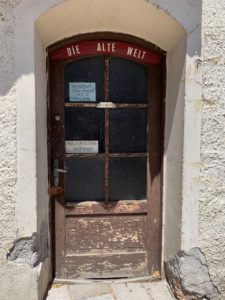
Travelling in Austria on the last Sunday in June, through a narrow mountain valley. While in Vienna the heat is record-breaking, here the air is cool and fresh. Also, I notice a large number and variety of insects swirling around. The only road out of the valley is blocked by a long procession moving between two neighbouring villages. Everyone has to follow, bikers, cars. A single policeman walks at the rear end, at a safe distance. I get out of my car and join him walking. People walk briskly, the distance is quite far. He is polite and friendly. We have a nice conversation about how every road nearby is blocked by important public events this morning, marathons, processions, races.

The procession halts at several temporary altars erected near the road. Some men carry crossbows and lederhosen, others uniforms but no weapons. Under his portable canopy, the priest generously distributes blessings to buildings, people, houses, animals, and fields, and calls for god’s protection for ‘our culture’. I wonder: am I part of this culture, as a composer? What would his reaction be if he heard my music? Do I contribute to an Austrian culture? Is there something we have in common, culturally speaking?

During my interaction with the people from the valley, I experience myself as an outsider, an ethnographer. The book title ‘The Professional Stranger’ comes to my mind. As a composer, I cannot help listening to the sonic performance of drums, brass band, marching, singing, preaching. A curious open air performance, a collective landscape opera, relentlessly immersive bringing everything else to a halt.
procession
Taking pictures and videos from an outside position, I feel intrusive. But then I notice locals filming, too: in the open doors of houses on the street, women stand taking videos with smartphones. Some of them wear aprons; probably they interrupted their kitchen work to watch. I will appear on their videos as well.
There is this one door with the inscription DIE ALTE WELT – opening hours only in the mornings.

19/07/2019
Meeting the composer: CARO C


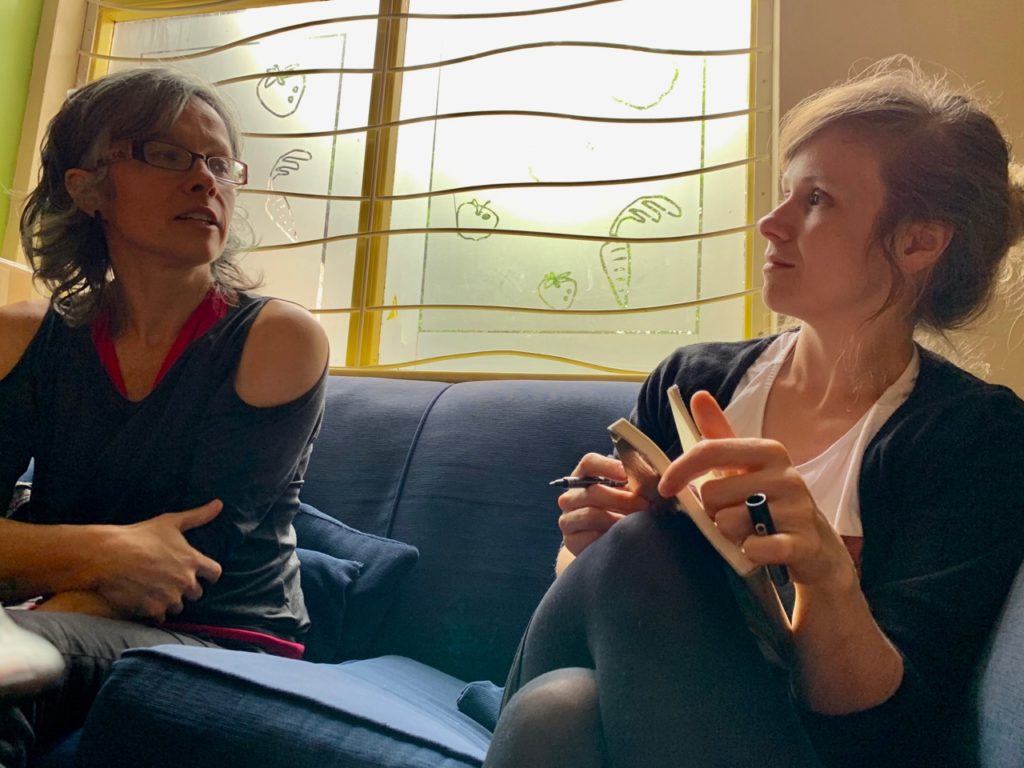
In a small cafe in Chorlton (greater Manchester area), Christina Lessiak and I meet Caroline P. Churchill alias Caro C for an extensive exchange and interview. Caroline is a versatile and imaginative British musician, producer, and composer of electronic music as well as music technology specialist; on her website, Caro C states: “Like many creative professionals, I have a variety of roles and specialisms”. Caro C also runs various educational classes and as well as community music projects. Her Delia Derbyshire Day has inspired many young people to become listeners and composers of electronic music. The interview is lively. We eat delicious soups and sandwiches, too. For me, it was a pleasure to listen to Caro C and watch her talking. Caro C is also an active member of the international female:pressure initiative.
Here is Caro C’s website: http://www.carosnatch.com
12/06/2019
EINS & DOPPELT #2
Here they are. I love these instruments! Two of them crowd my living room this afternoon, I feel so privileged to listen to their luxurious sounds. Artistic swimming, historically informed. Thanks to Molly McDolan and Ana Inés Feola for the rehearsal. Artistic sweating, with temperatures well over 33° in town.
EINS & DOPPELT #1
A duet for two oboes da caccia will be rehearsed today. The performers are asked to coordinate their right hand gestures, for a specific vibrato technique I found through experimentation. I have termed the movement a ‘sweep’; it works with historic recorders and oboes, or similar instrument without keys, or only very few keys.
EINS & DOPPELT is a passage from a poem by J. W. Goethe, the one about the gingko leaf. I used the line in a multimedia performance lecture on the topic of vocality and instrumentality. I explored the topic from a performer’s perspective. When I perform, both vocal and instrumental action merge. I constantly talk and speak and articulate. In playing recorders, articulation is so essential. Even more so for the bass recorders: articulation helps to coax the long air column inside into vibrating.

11/06/2019
Suddenly, summer’s heat waves
crash on to the city. My mode of working changes with the temperature: more languid, slower, more physical. I notice my body more directly. The piece for cembalo solo is finished, I look forward to hearing it soon. It will be embedded into the new version of DUSK SONGS, woven into a text passage about the light of the pale winter sun. In betwen composing, I reflect on music and democracy, for an upcoming preseantation with Christina Lessiak in Huddersfield. How does feminism connect to democracy? Currently, I read publications by Dr. Christina Scharff, such as her 2016 book Repudiating Feminism. Young Women in a Neoliberal World (New York: Routledge). I like her concise descriptions and reasoning. Among composer colleagues in Austria, I seldom mention the term feminist, it makes me feel uncomfortable as artist. I want to hide and protect my feminist self – as Dr. Scharff explains, many young professional women avoid the term, too, because they don’t want to be under attack, regarding their work.
My work is not intended to be feminist – not at all. Rather, my compositional process and artistic practice evolve in a feminist way. Regardless of the result, I act politically. In composing, I approach reality and imagination, sounds and noises from a feminist point of listening. In my experience, this is often misunderstood; I’m not interested in compositional activism. The link between feminism and my practice is my listening perception. My perceptional process mirrors my way of thinking. In my practice I am true to myself: feminism shapes my perceptional process.
06/06/2019
I’m back at my desk.
The transition takes time: my mind, body, ears slowly settle down into another flow of exploring the more inner worlds as I turn from performing to composing. The weather is warm and gentle in Vienna, the first summer days after an extended cold period. Birds flock to my window sill, where I place a bowl of seeds ready to be picked up. A blackbird sings, quite unusually loud.
The cembalo: a challenge. I work on a microtonal piece, with two registers tuned a quarter tone apart. I imagine the sound of the instrument, I don’t have one. I feel that I’m in love with the silken sounds of the instrument. Will the music be too conventional? Am I becoming too baroque? What does conventional mean? Is contemporary music yet another convention? The instrument has a quality of its own, I have to accept what it is, how it works. I have to surrender to the history of the instrument: baroque gestures come to my mind. Flow, and halt, and flow, and halt. Stop and think. Move forward. Aristoteles: fantasmata.
The cembalo is haunted by fantasmata. They creep into my mind, they occupy my imagination.

01/06/2019
I spend a few days in Graz
for the biennial V:NM Festival of New and Improvised Music. One of my favourites: democratically organised – everyone who is a member of the community can perform. The format still works. Lots of interesting performances, various genres, one after the other, nice audiences. I’m filled to the brim with sounds and noises. The workshop and performance We Say We Sound with five vocalists from the Jazz Department of the KUG Kunstuniversität was one of my contributions. The performance took place at the lofty bridge of the IEM Institute of the university; the project was part of this research (see under art & research). Very much enjoyed the collaboration, and performing together. For me, it was an experiment, too.

30/05/2019
Twice happy day.
I just finished the duo EINS UND DOPPELT for two oboe da caccia instruments, – rather late, I confess – but luckily. The caccia performers are asked to move their left hands in synch, using a specific playing technique I termed Sweeps. Hopefully, it will look like minimal artistic swimming; it does result in a watery, liquid timbral colouring. Further, I feel better today, yesterday I had a fever, and my mind was somewhat blurry, running high.
In the very beginning of my piece, I had written the instructions playfully, announcing her arrival over the staves. That’s what these instruments often did, in the Baroque era: one or more caccias (what is the plural of these instruments, anyhow?) announcing someone, something. After writing the last note, I switched back to the news page to find out about the latest developments in Austria’s shifty political landscape. Even on holidays, like the one we have today, the reorganisation of the government must go on. And wow, we have the first female chancellor in Austria’s history! Congratulations, Dr. Brigitte Bierlein. Lovely coincidence, as if the piece was written just for the occasion! Now, I open a nice bottle of beer to celebrate.
This picture was taken at echoraum, during the performance of the first version of DUSK SONGS in May. Molly McDolan performs a solo with her caccia, Caroline Mayrhofer echoes with the recorder.

29/05/2019
Cool weather in Vienna
is helpful these days as I work to finish a duo for two oboe da caccia instruments. It will be part of the new version of DUSK SONGS, to be performed in June. From my desk, I watch the rain and the branches of the big fir tree and the birch dancing right outside my window – rough winds do shake the darling buds of May. The long, slender branches of the birch and the heavy, dark branches of the fir: the trees follow their own rhythm. The twigs of the birch twirl in long, elegant, sideway curves, the dark branches of the fir shift up and down, reverberating. I sense their weight, texture, material, and flexibility as I observe their flow. The sensation extends from the visual perception and happens on a bodily level; I physically understand how they move. I am in touch with the branches, I connect to how they anchor on the main trunk. Beyond the surface of the visual, I listen into trees and their motion.
Austrian politics in a rough turmoil these days. Checking in for the lastest developments, I spend much time online. Reading and writing, as I want to contribute to the ongoing discussion, I follow the surge of postings popping up, on this online platform I participate in. A visible staccato rhythm, fast and relentless. No time to read, to listen.
